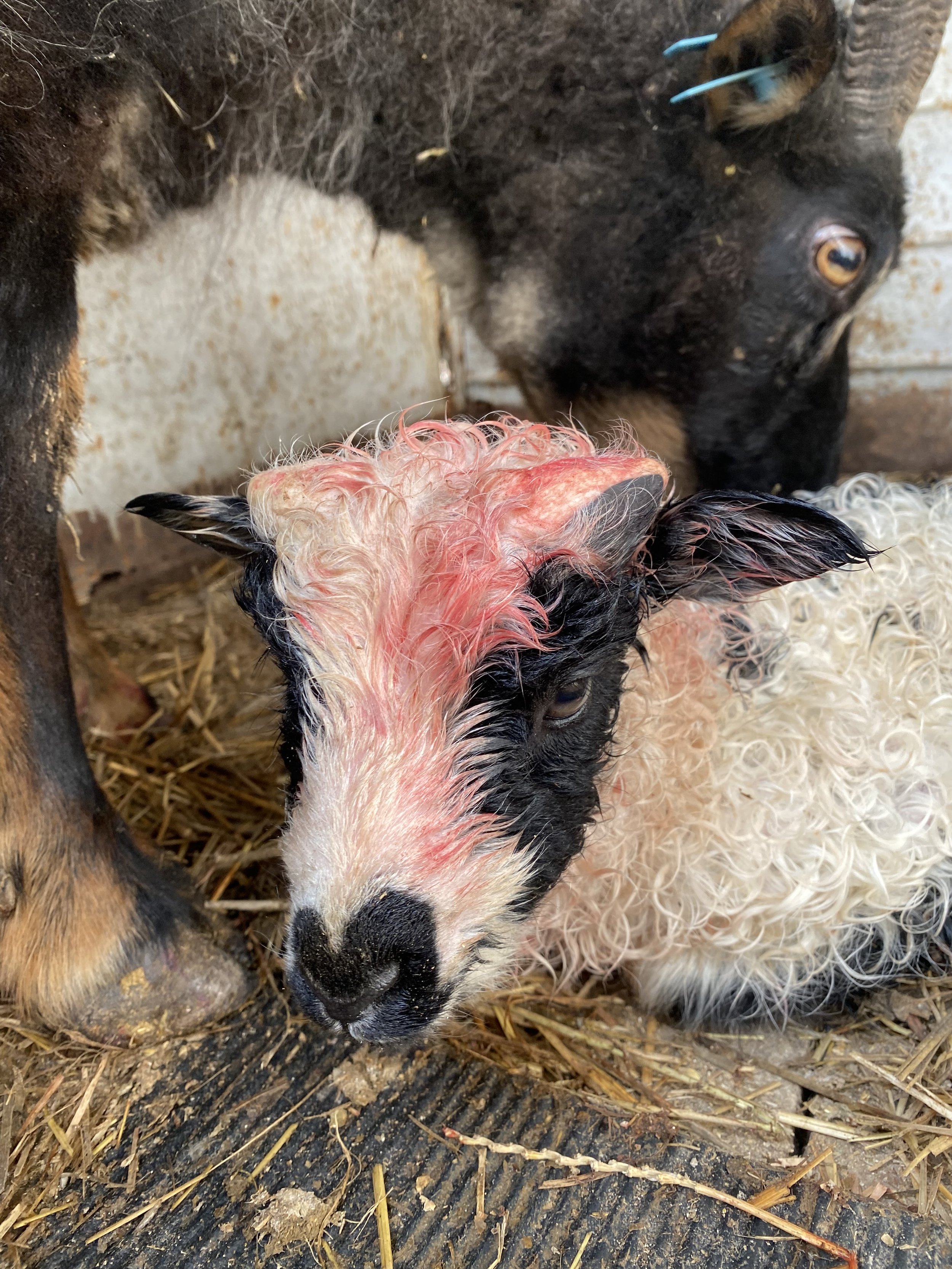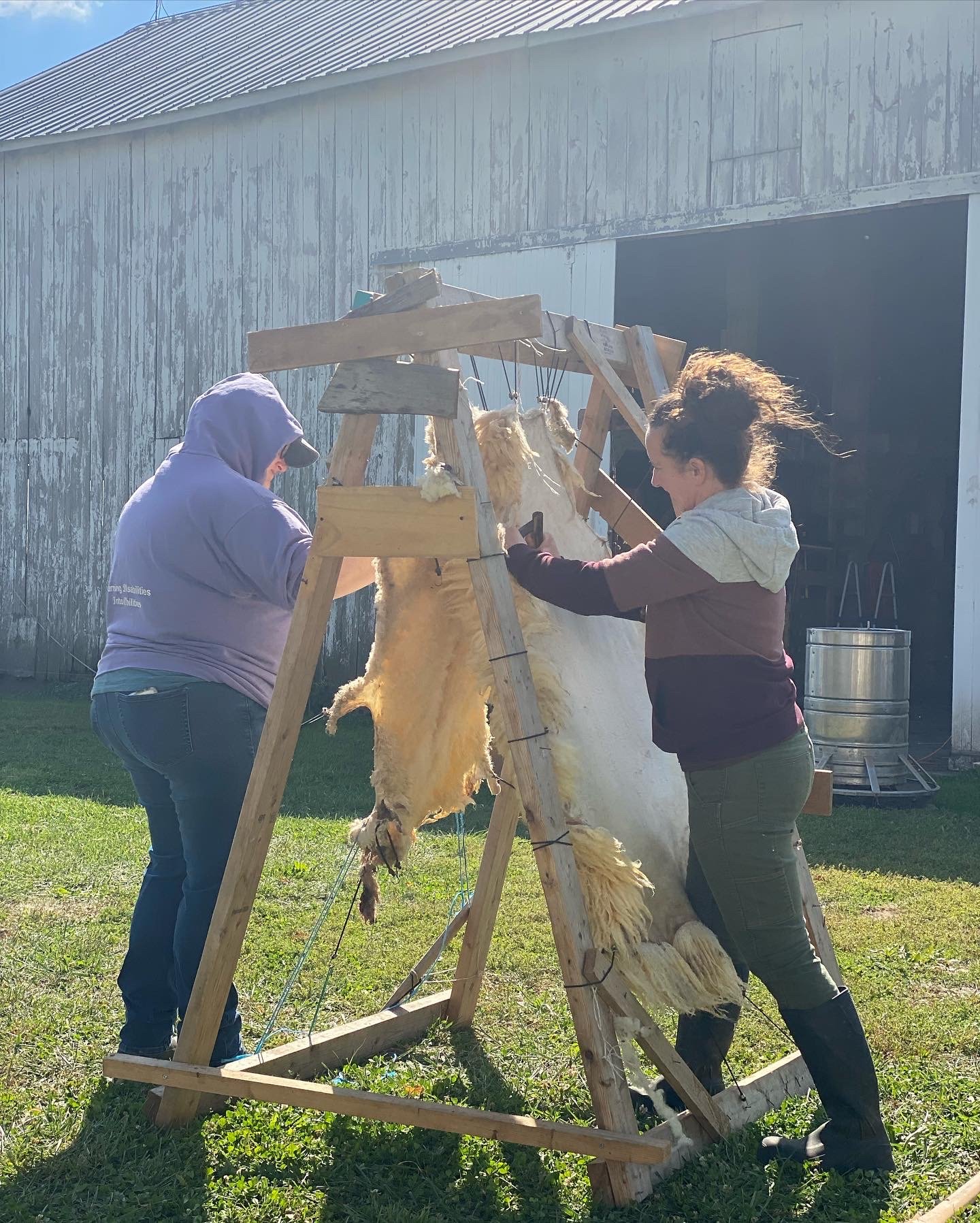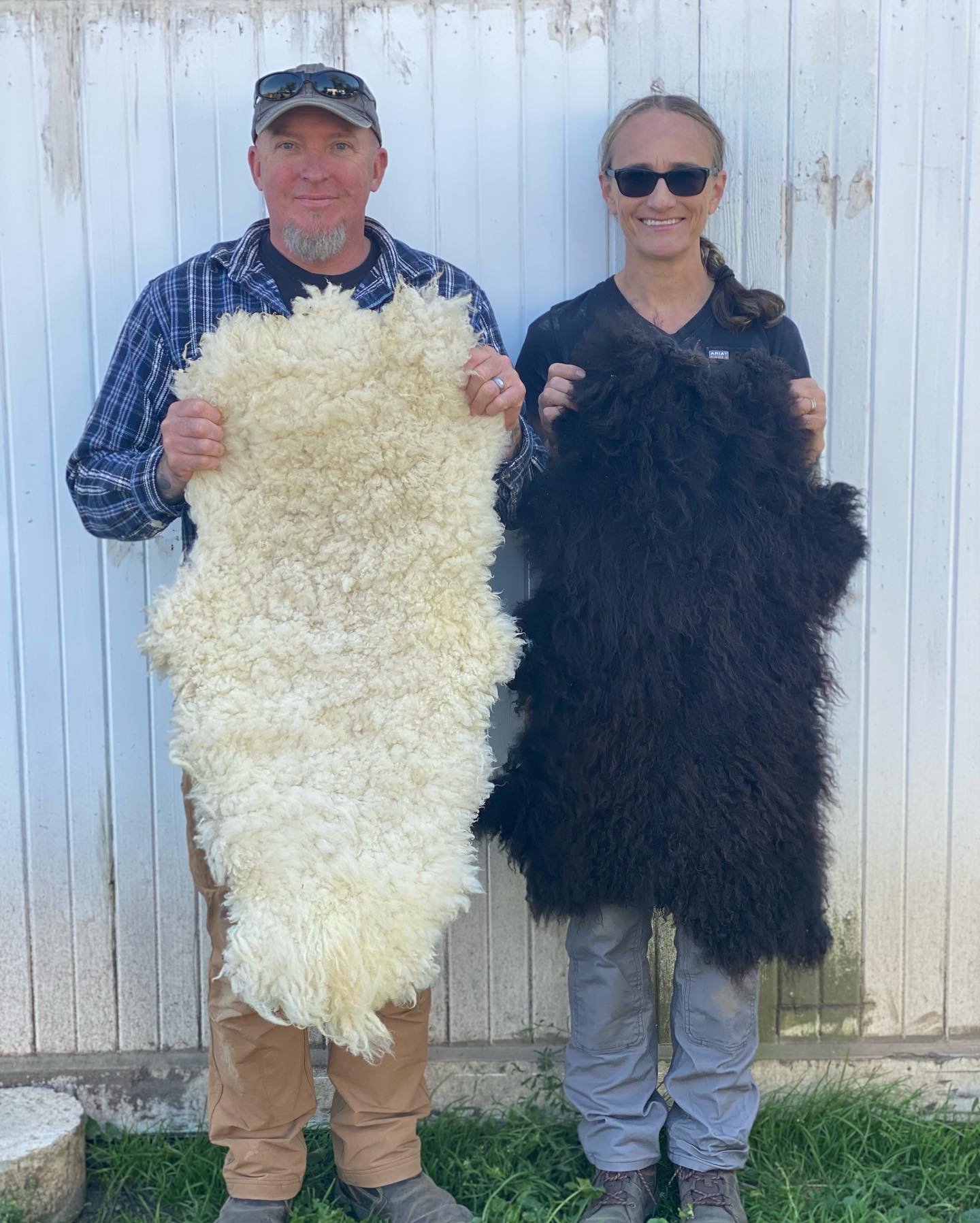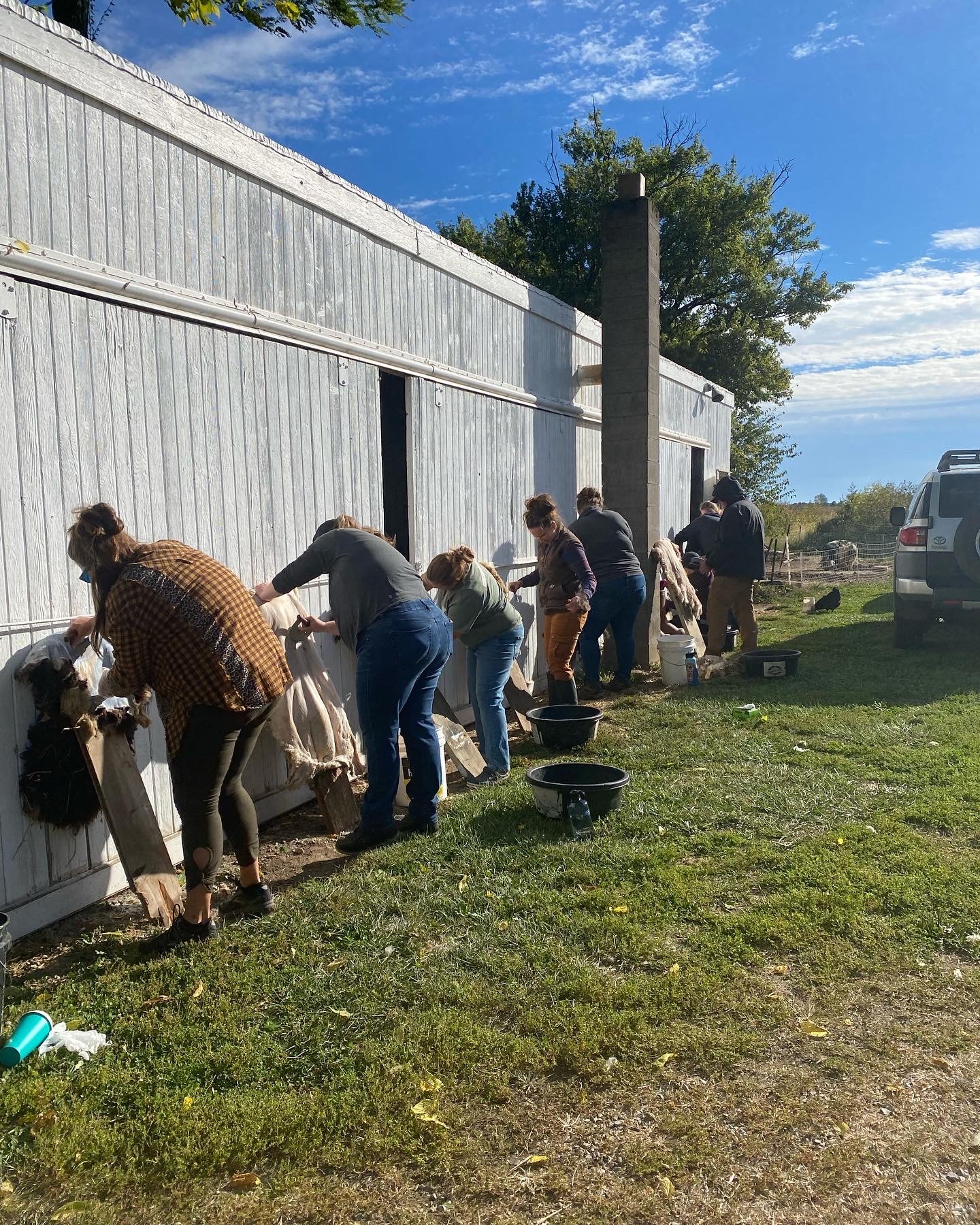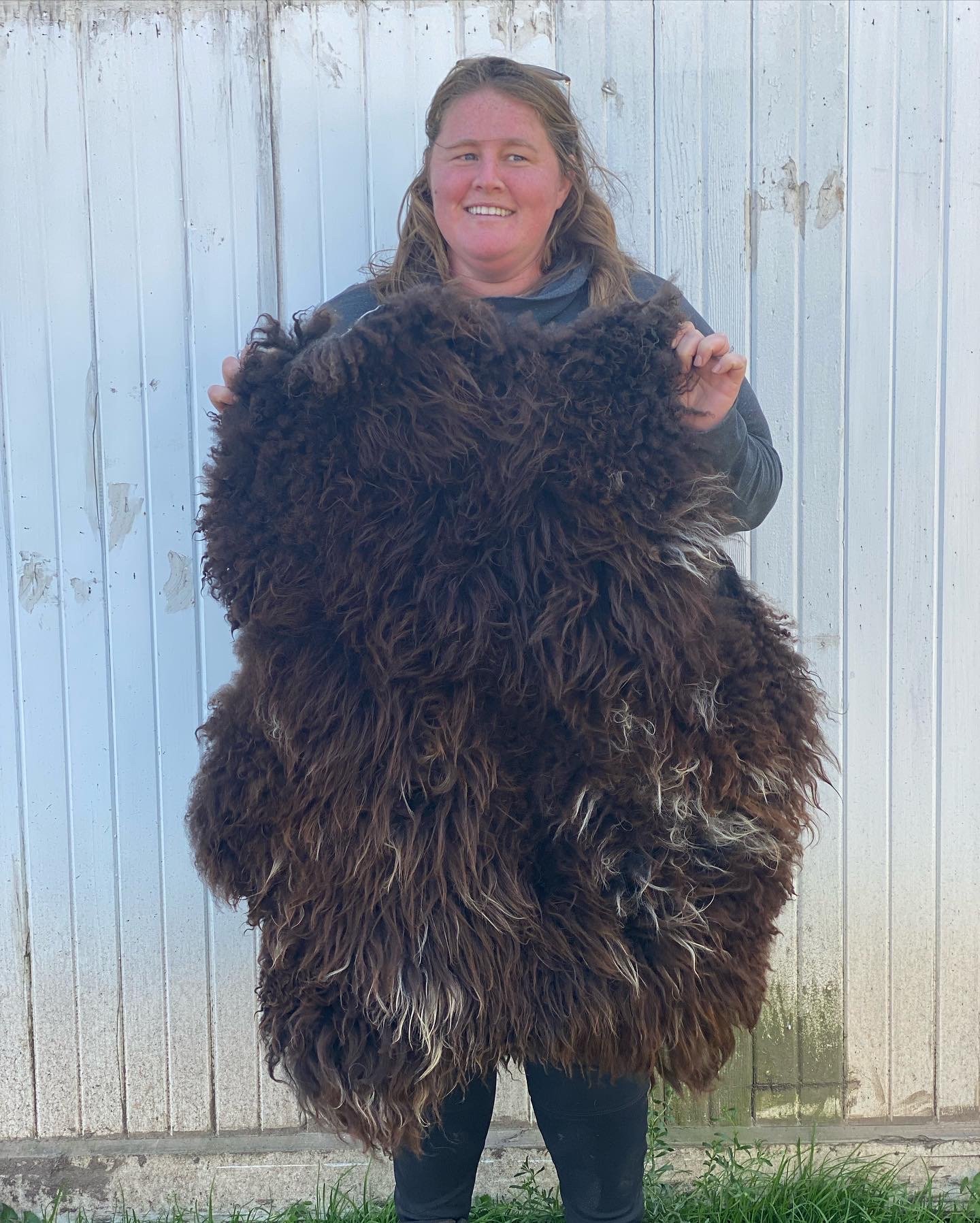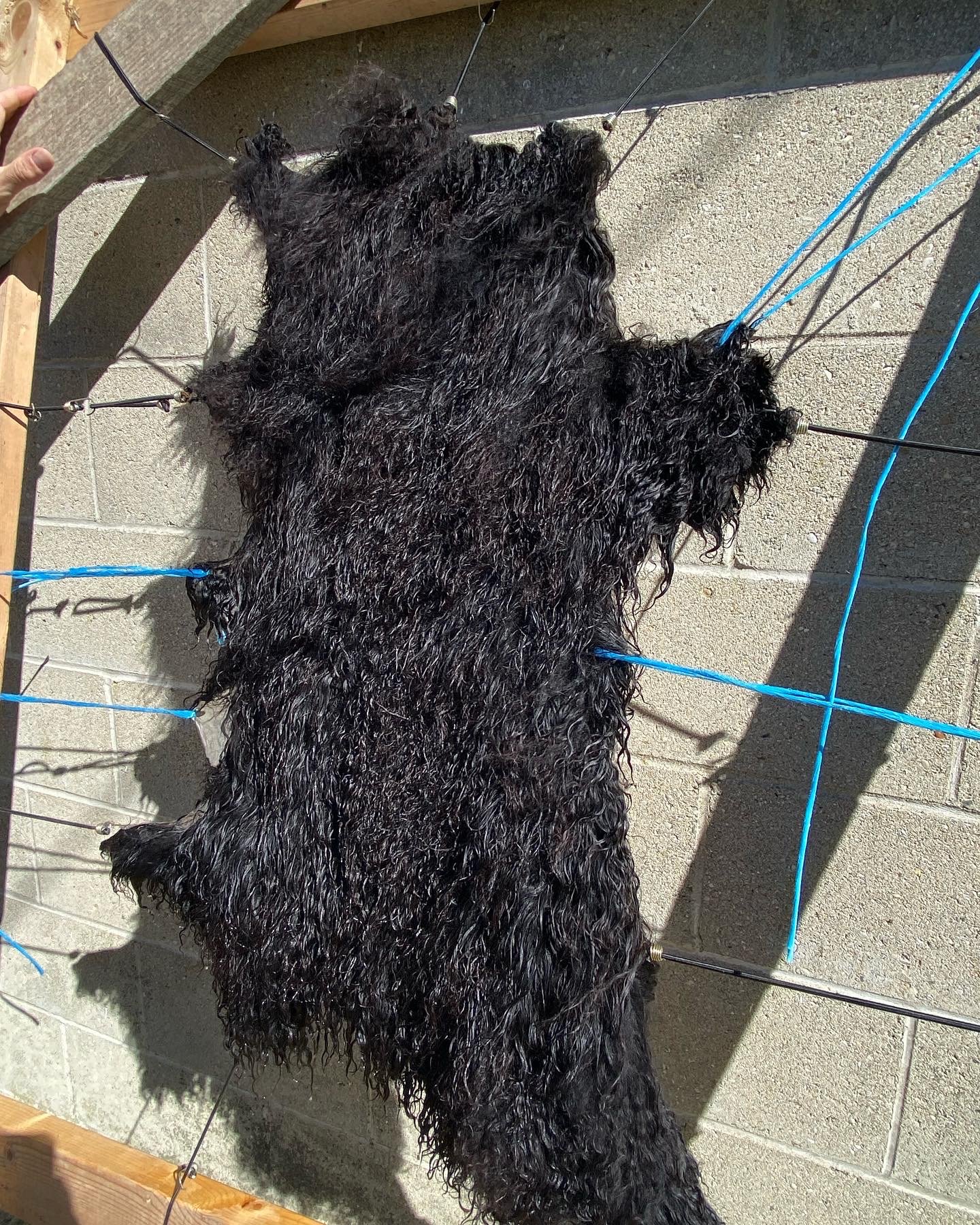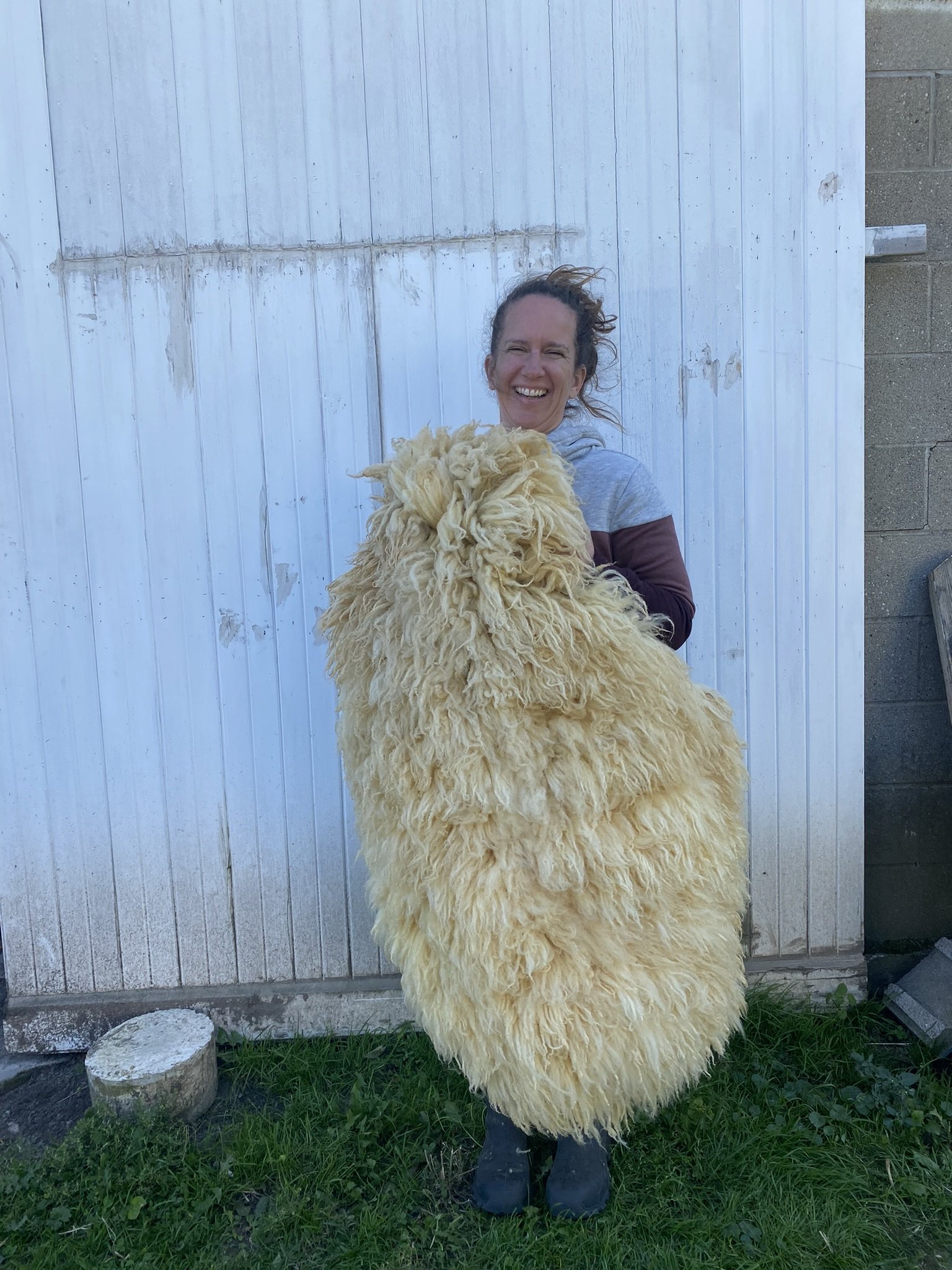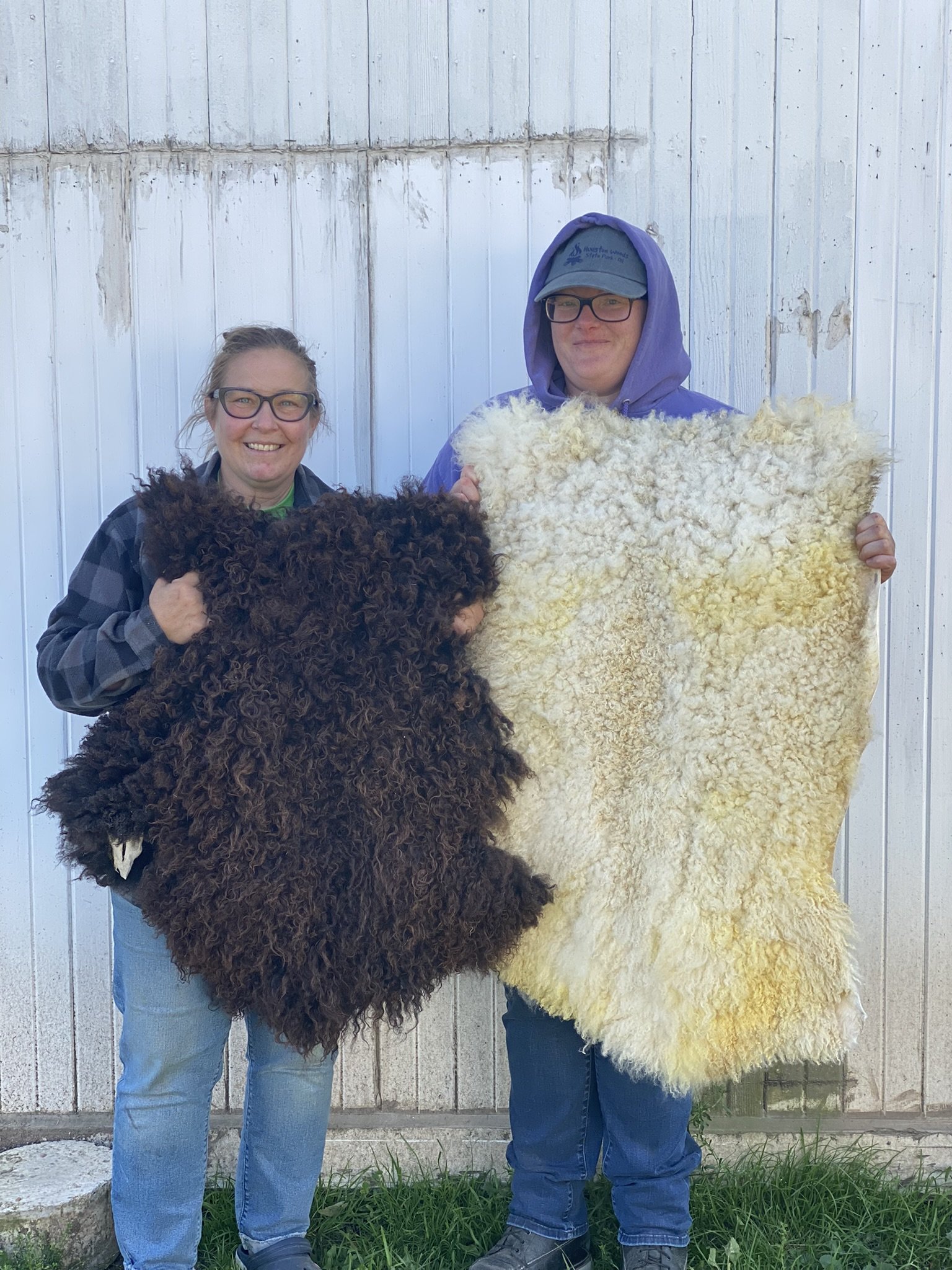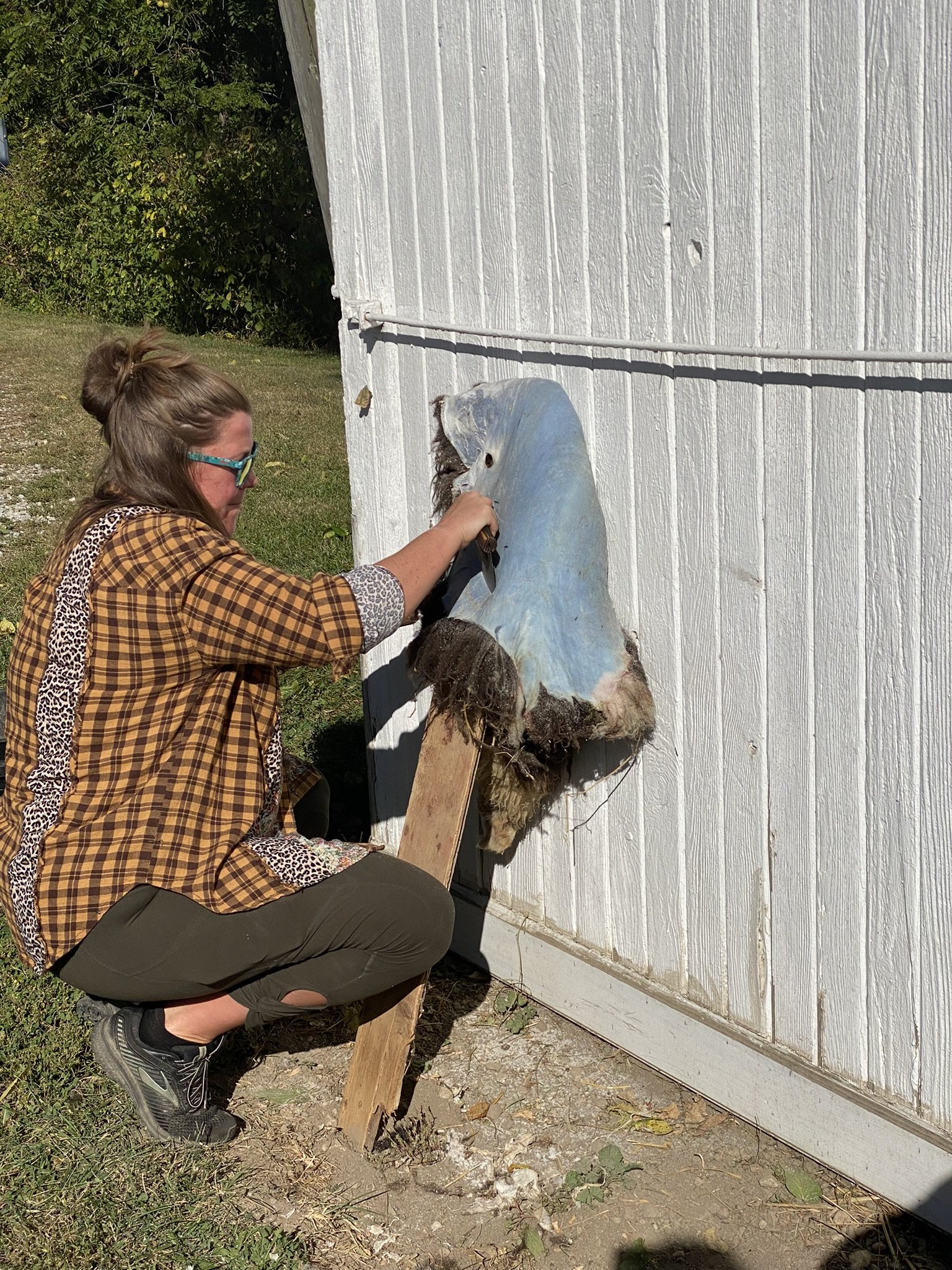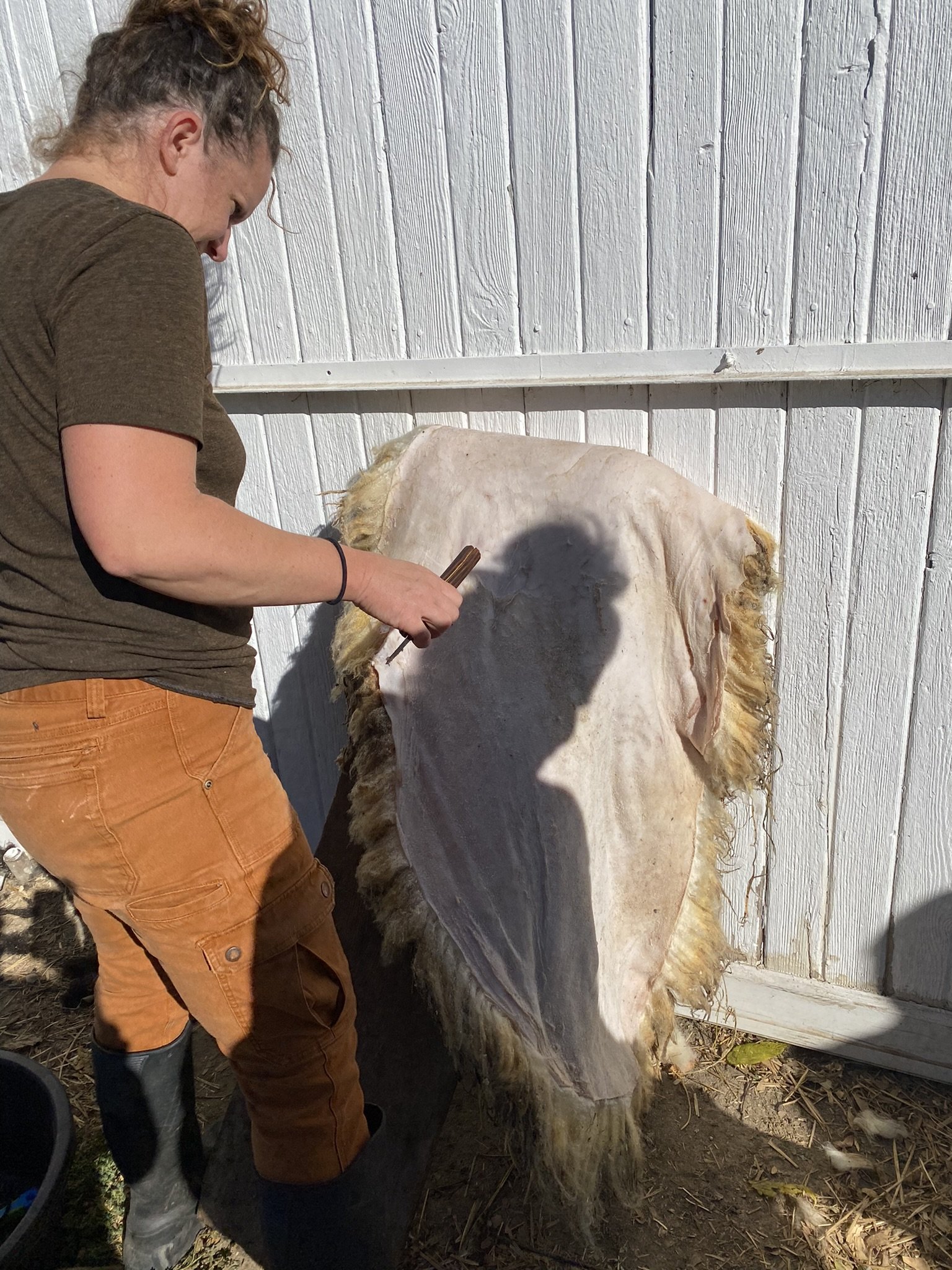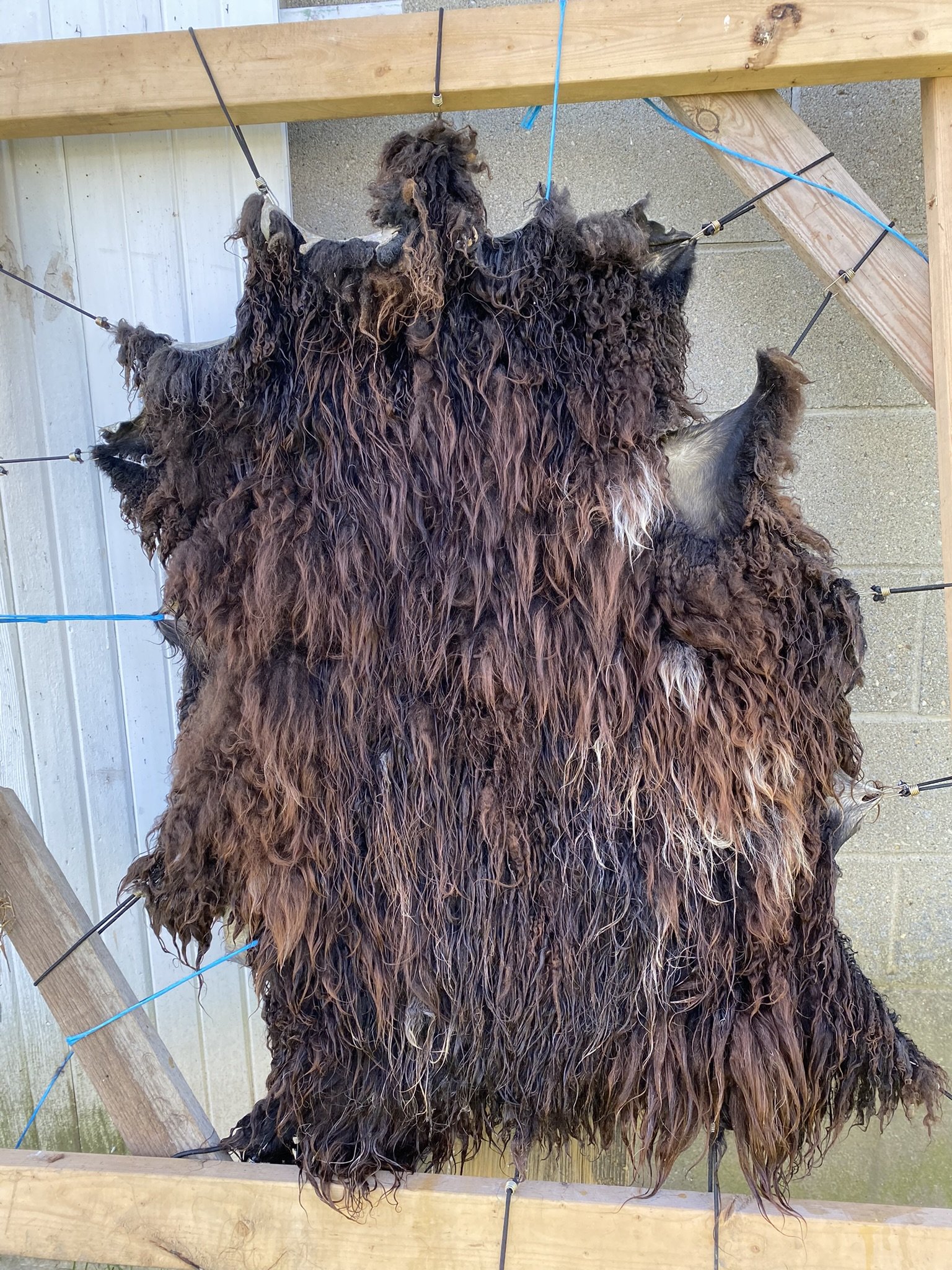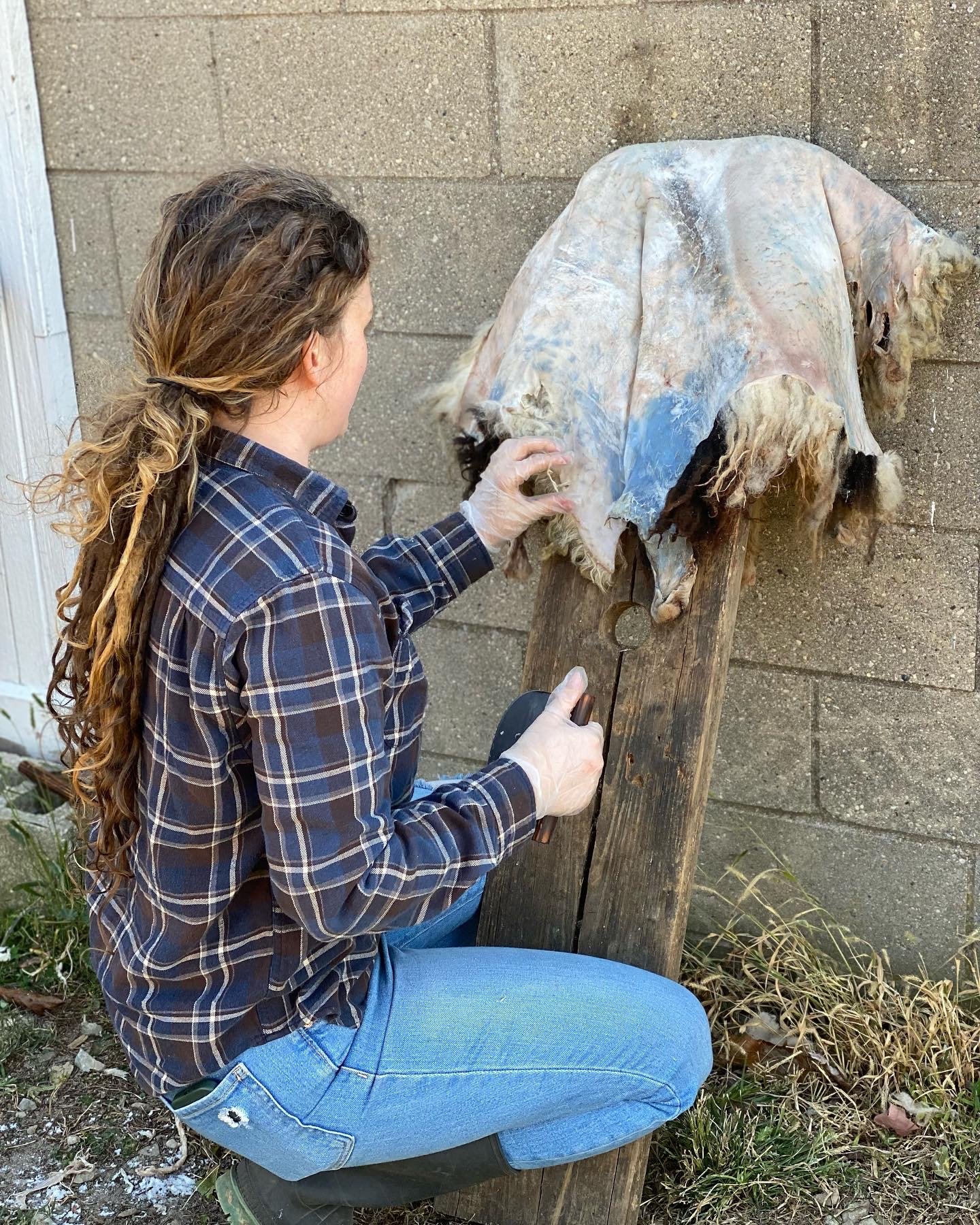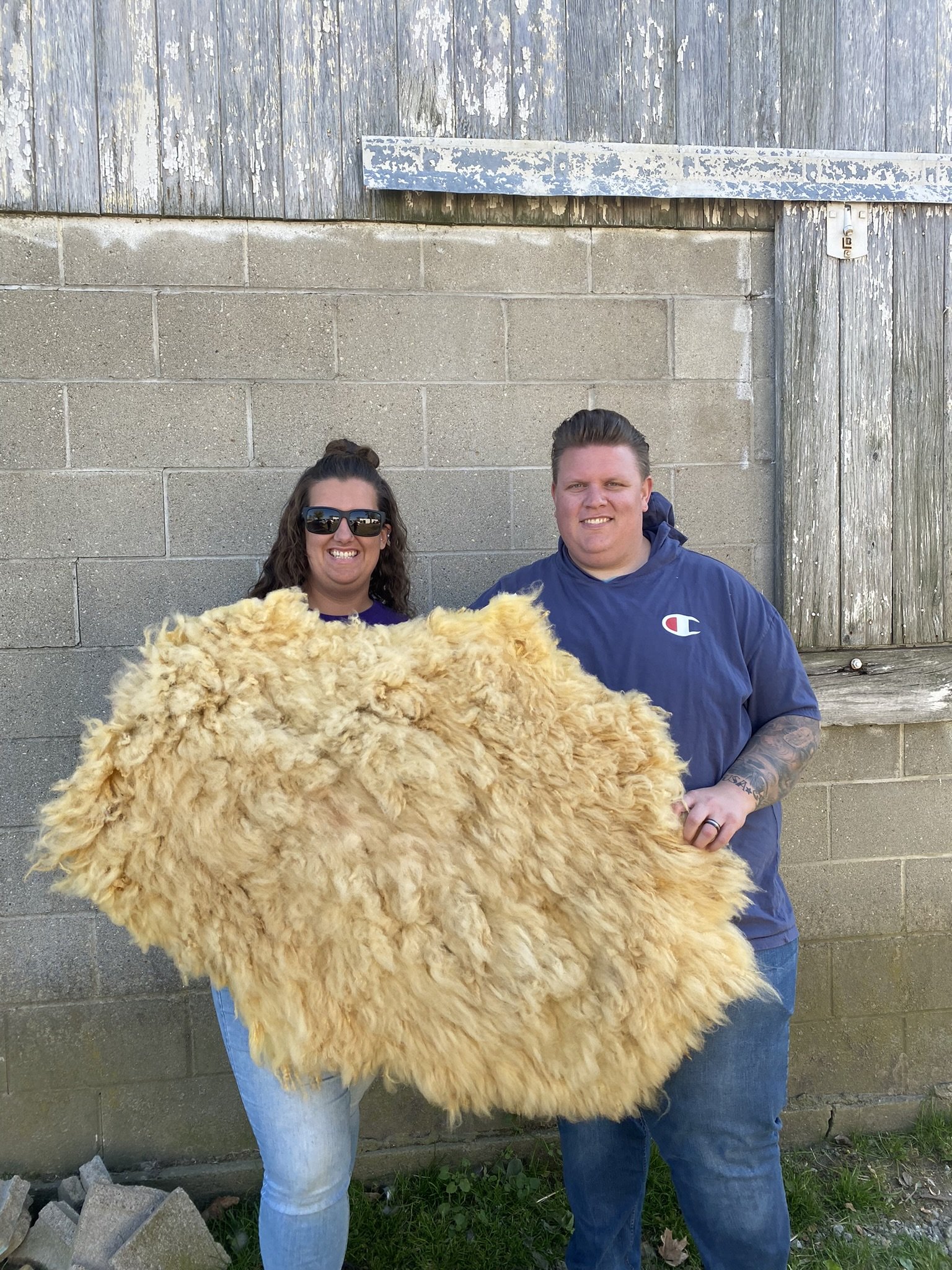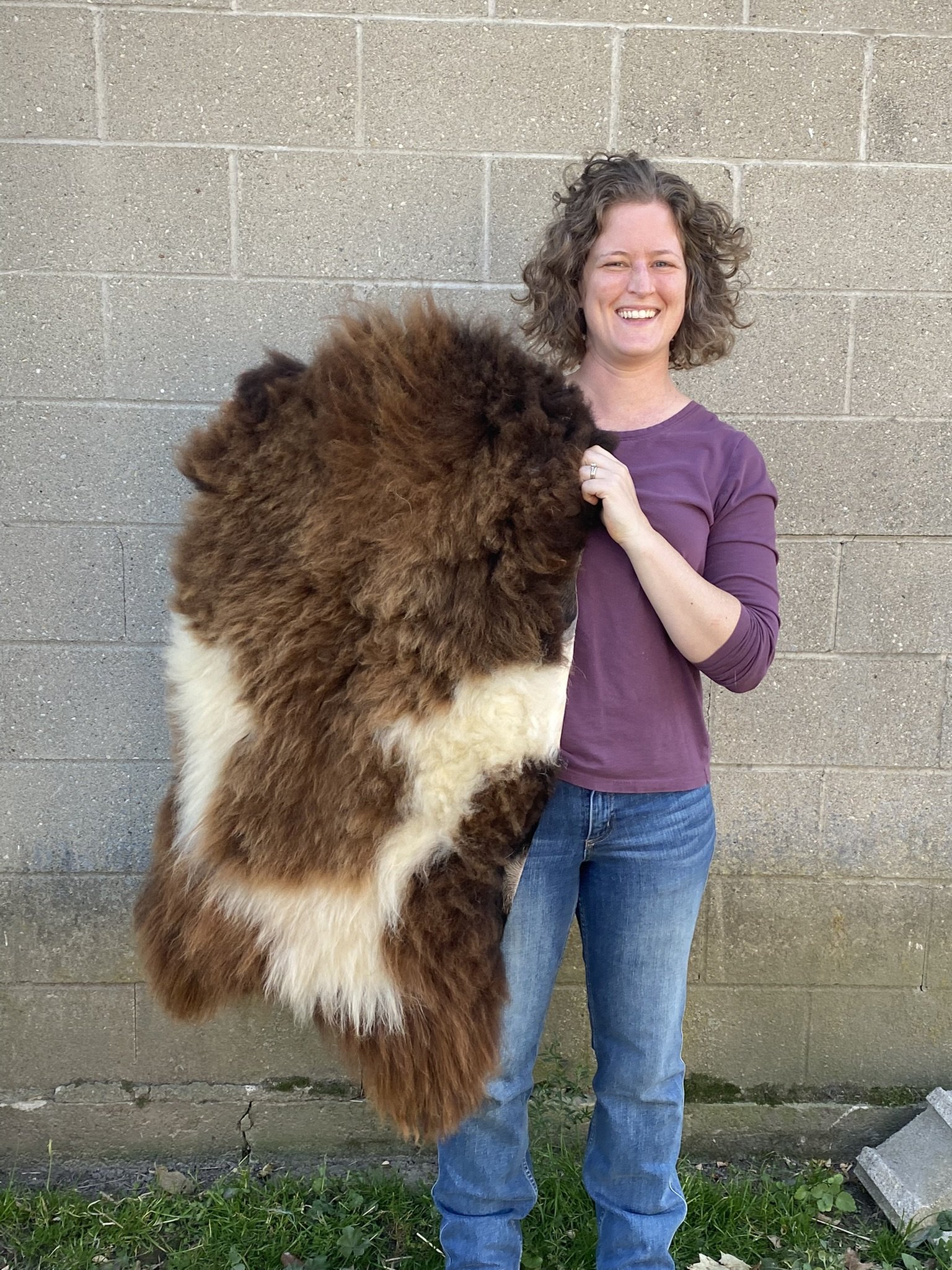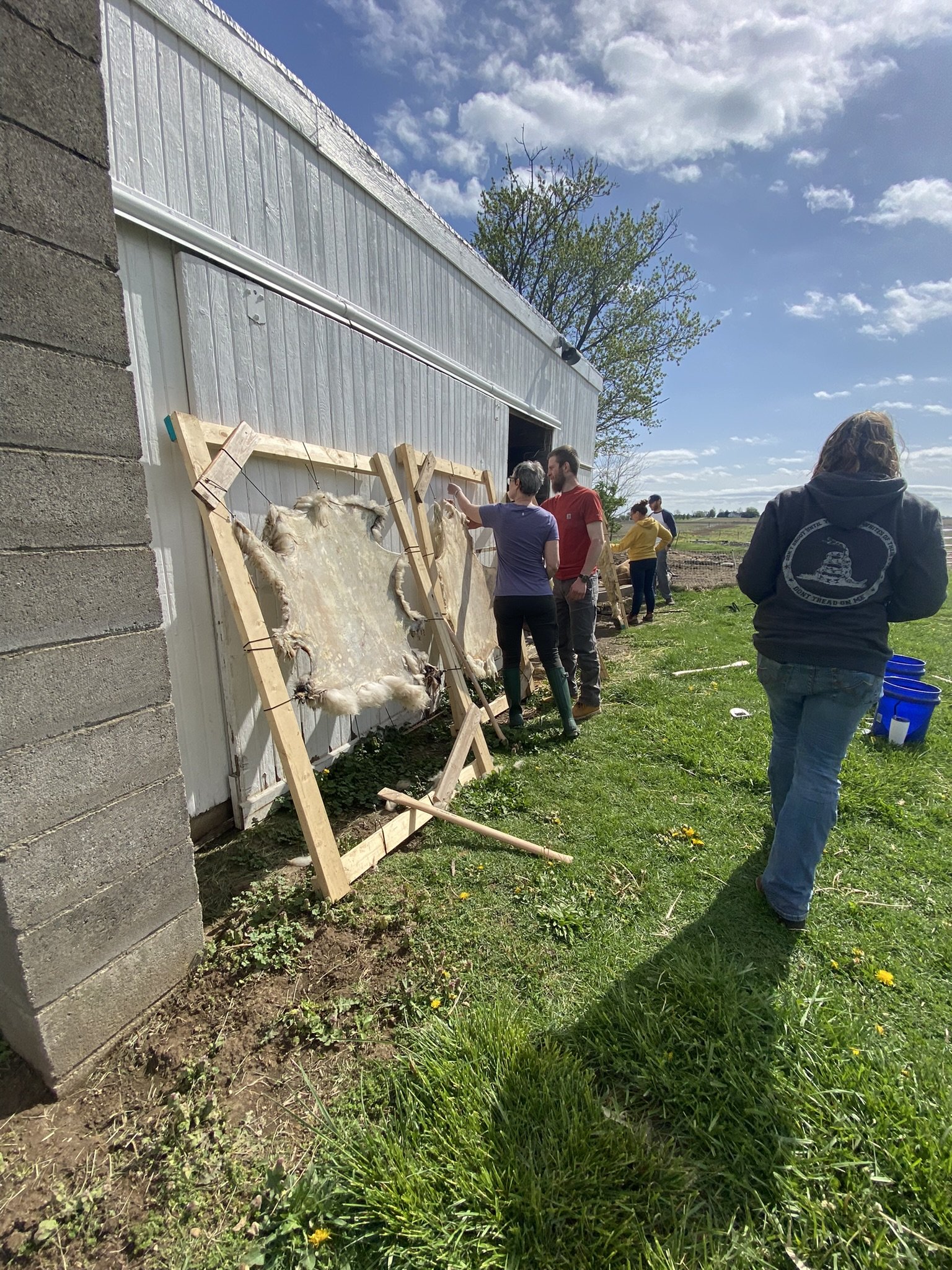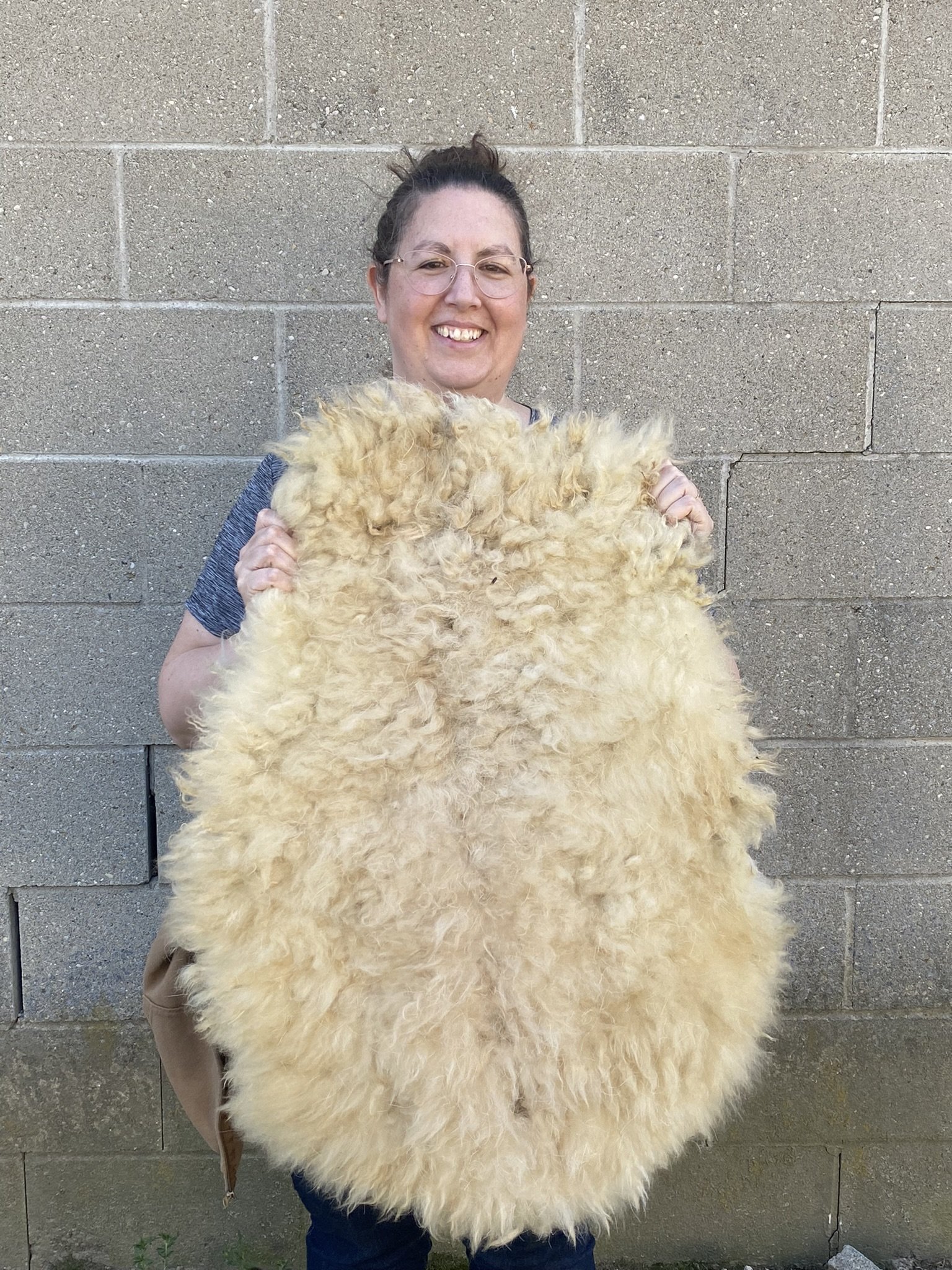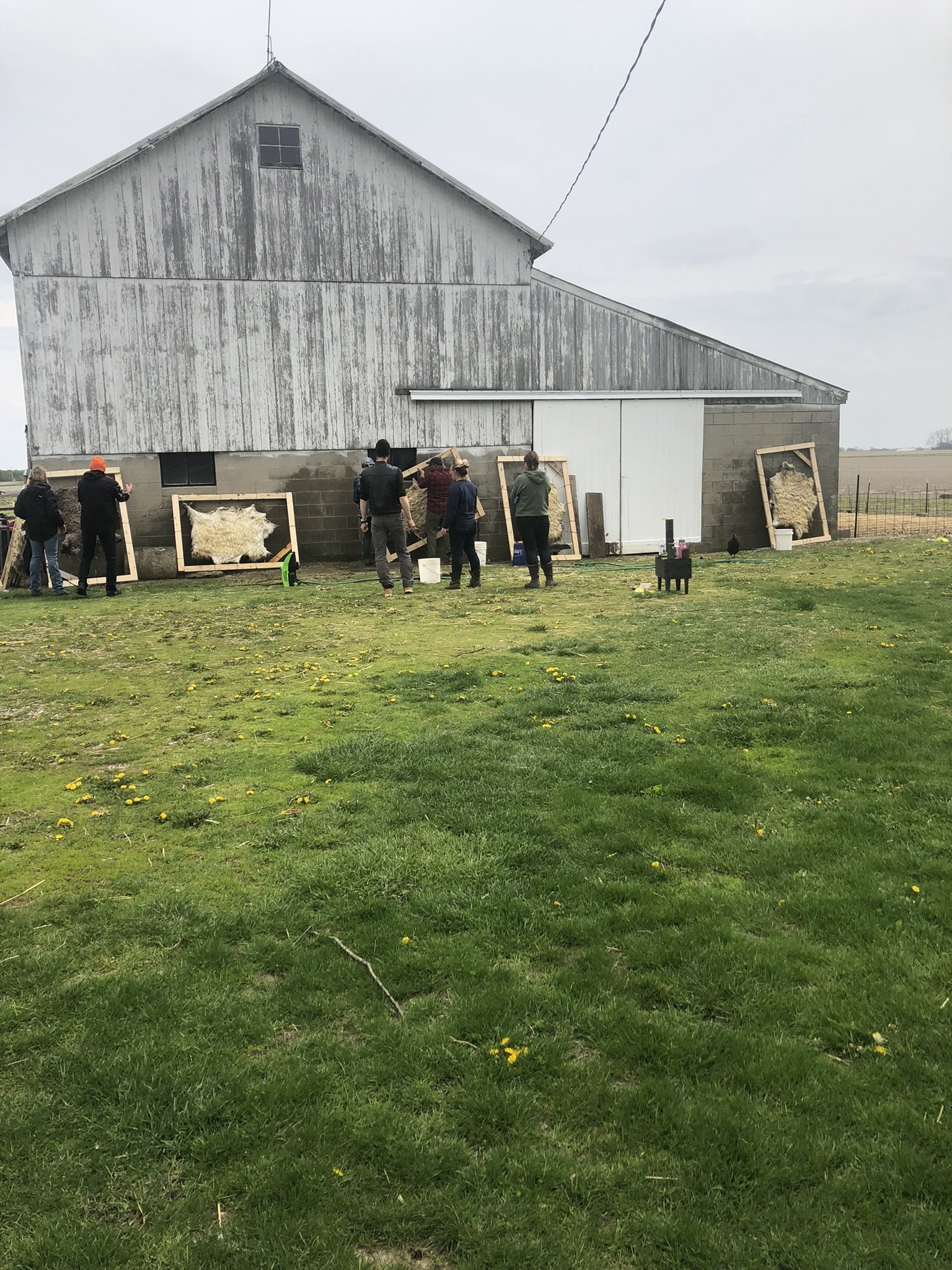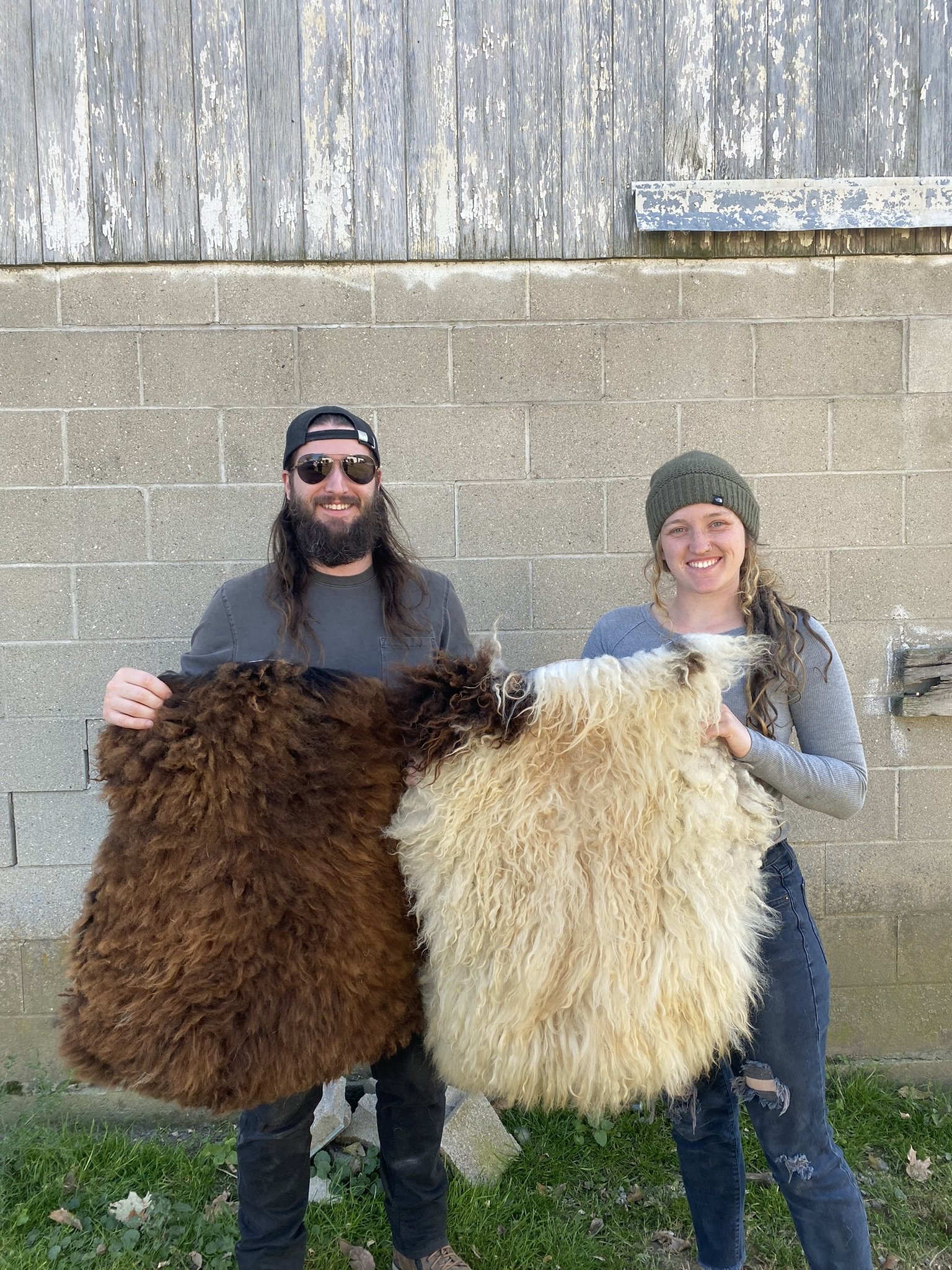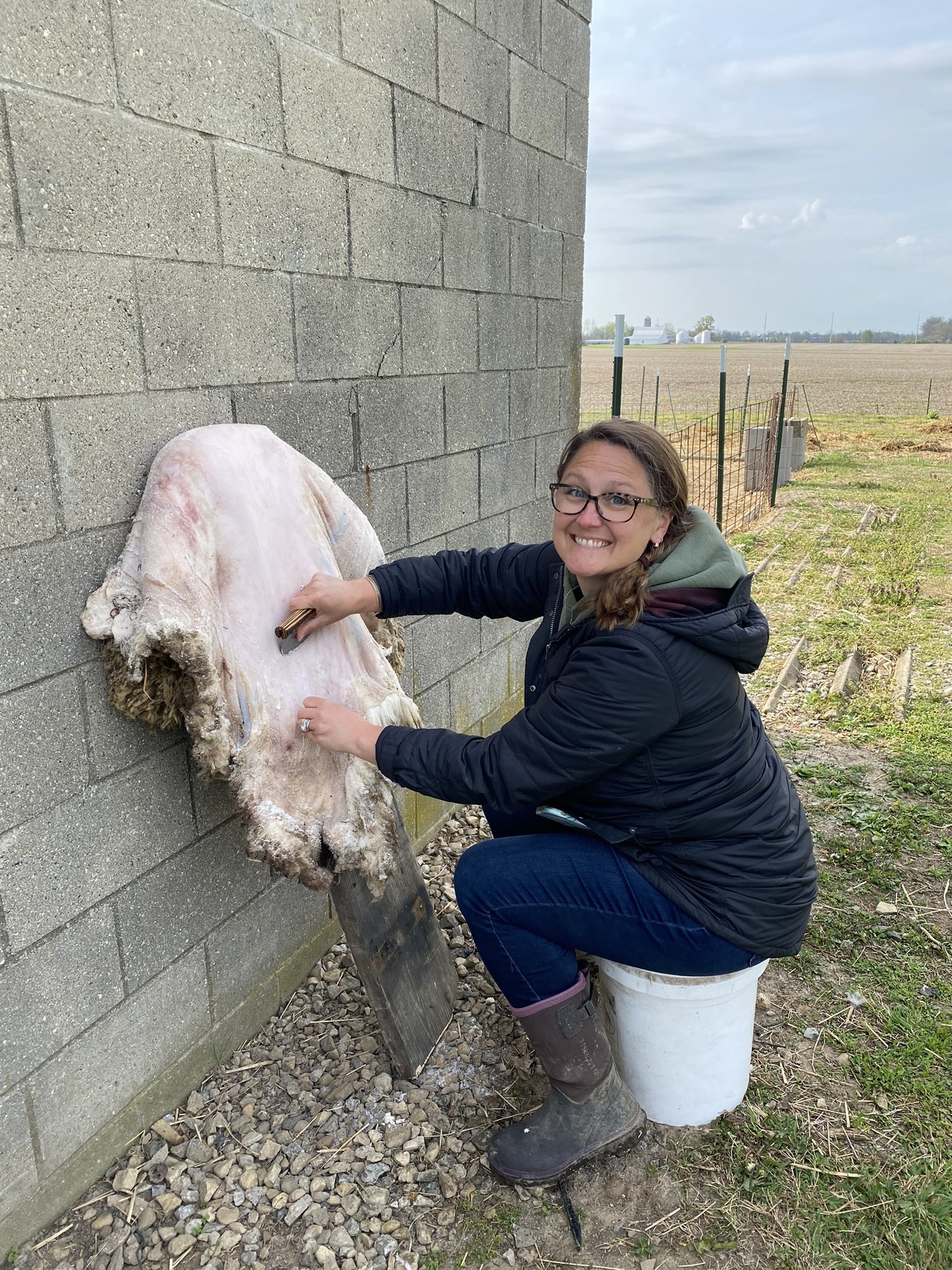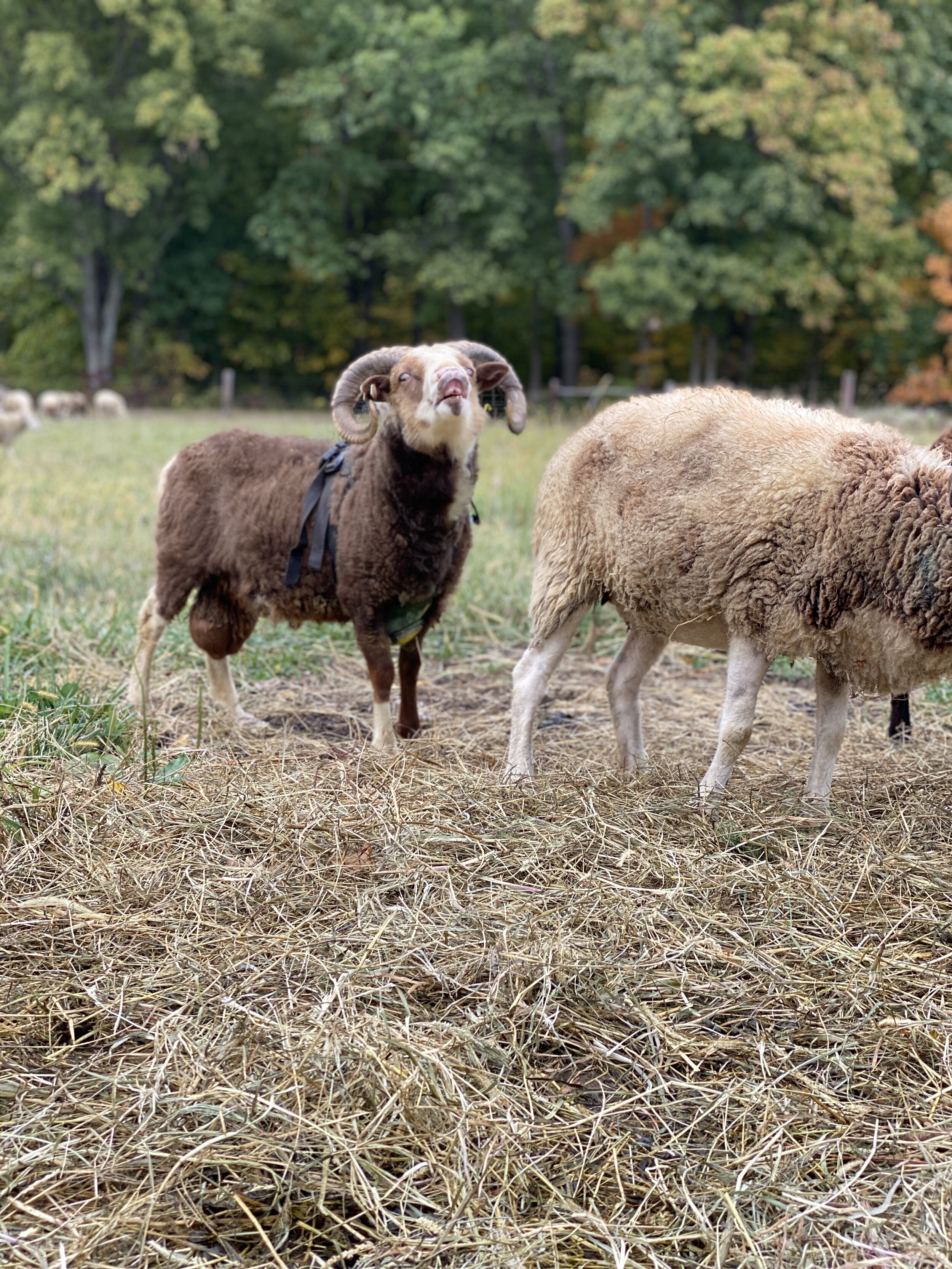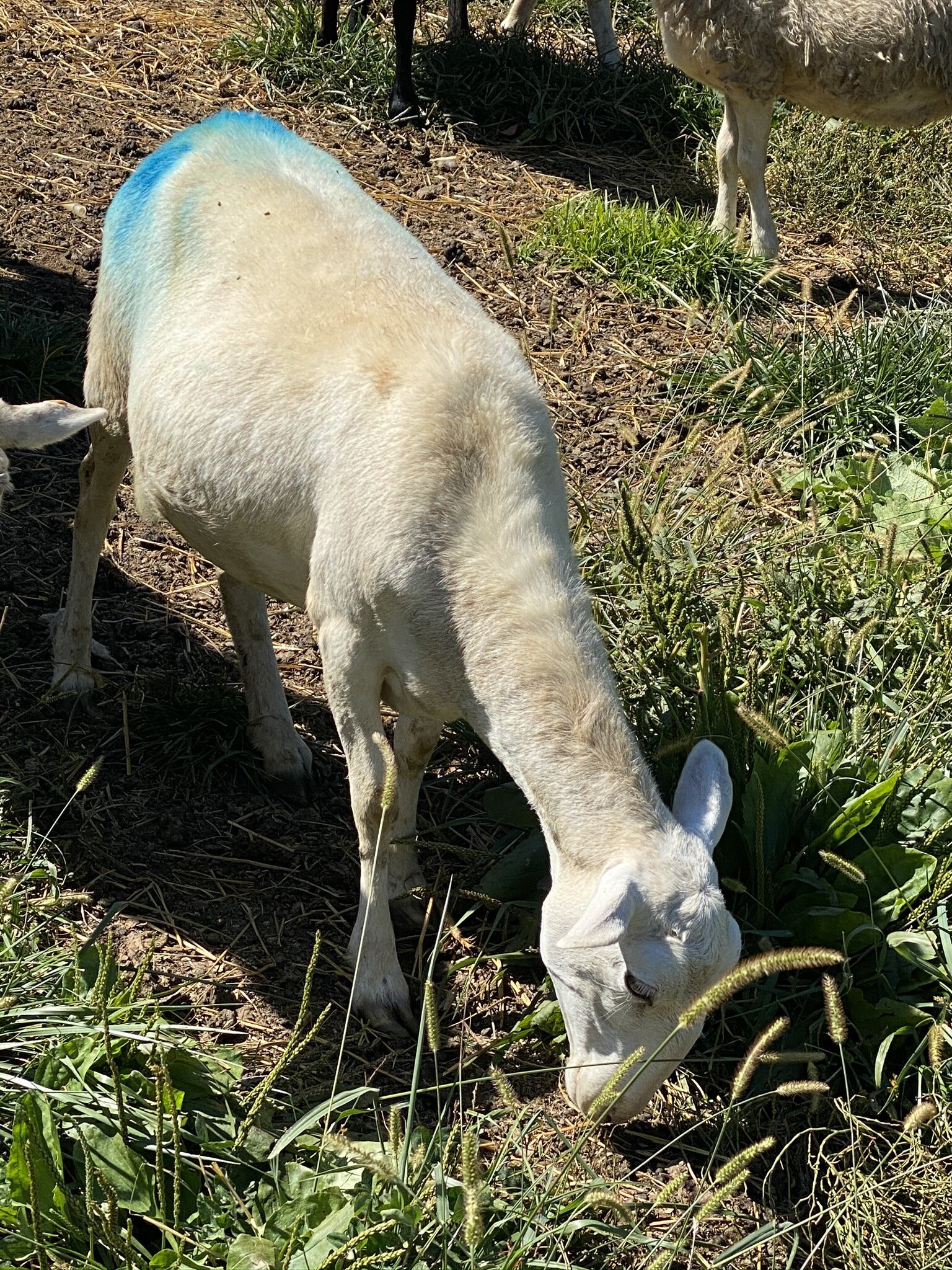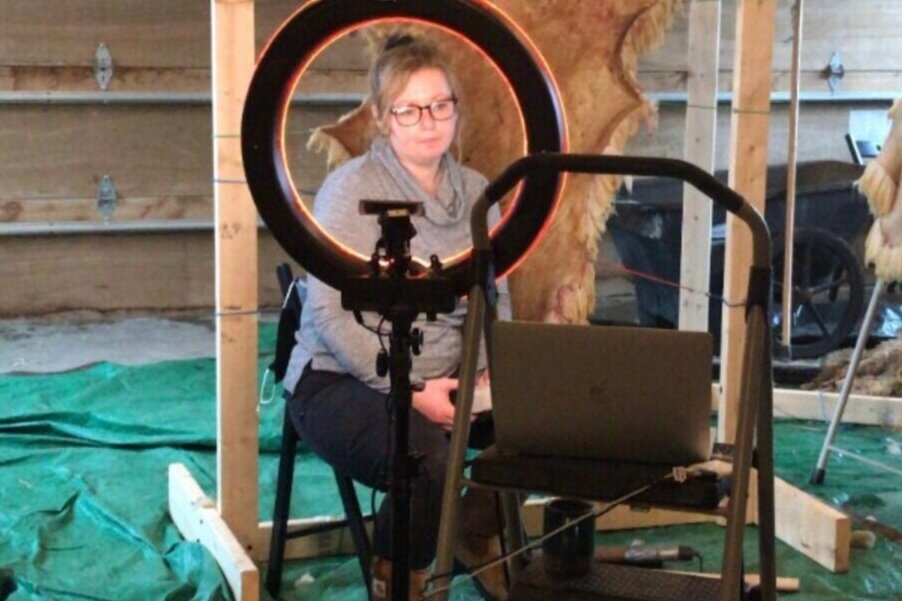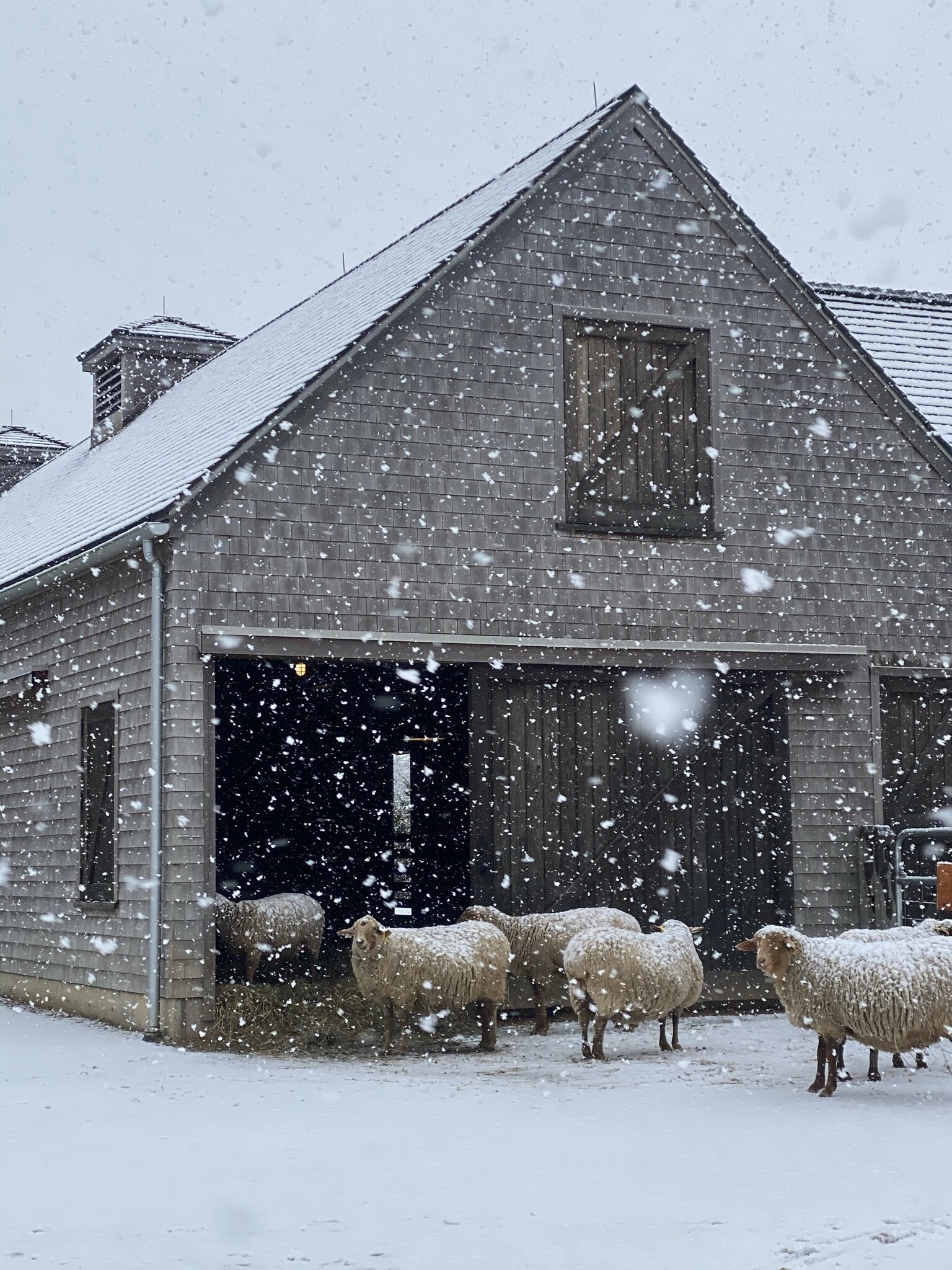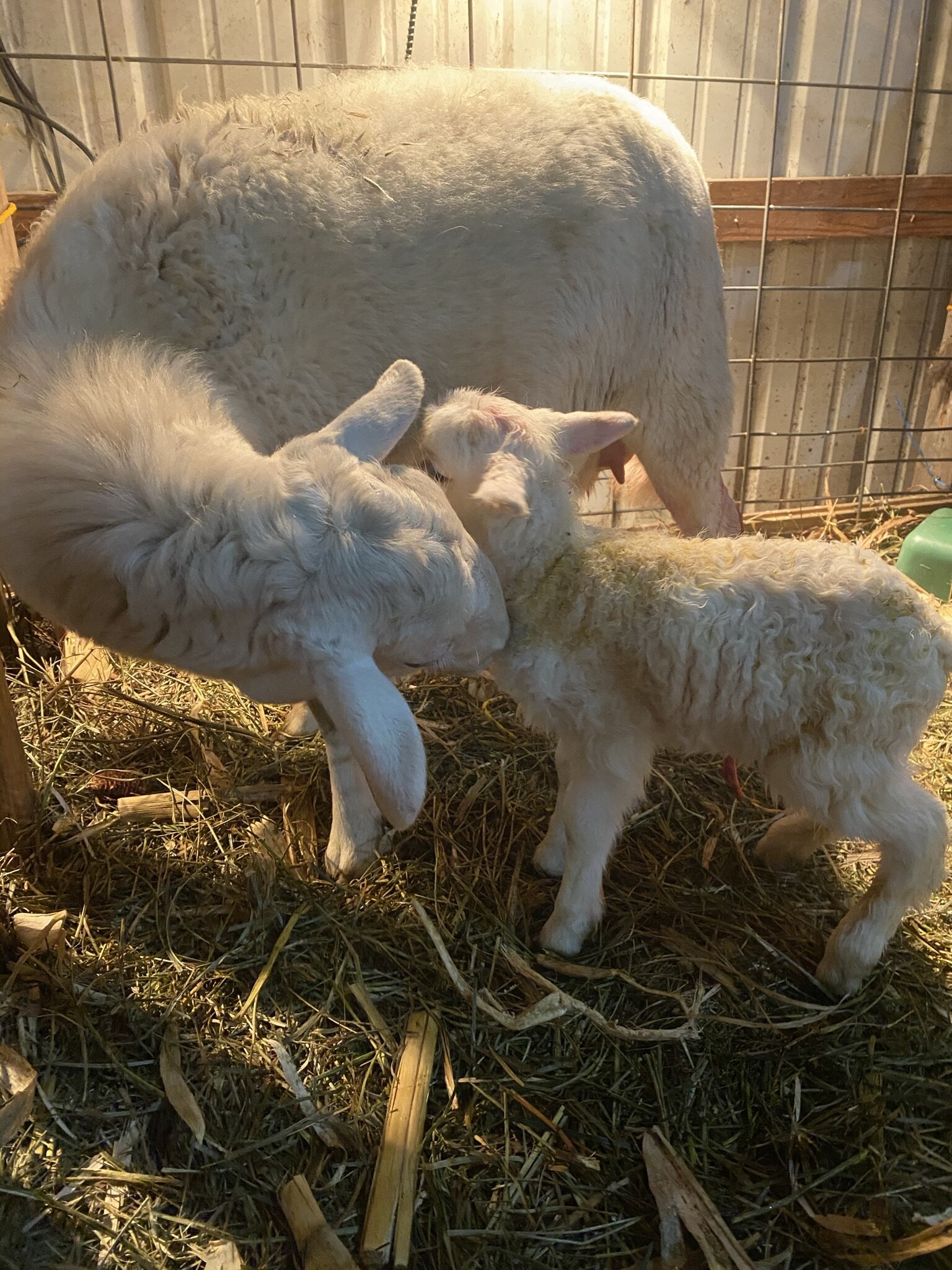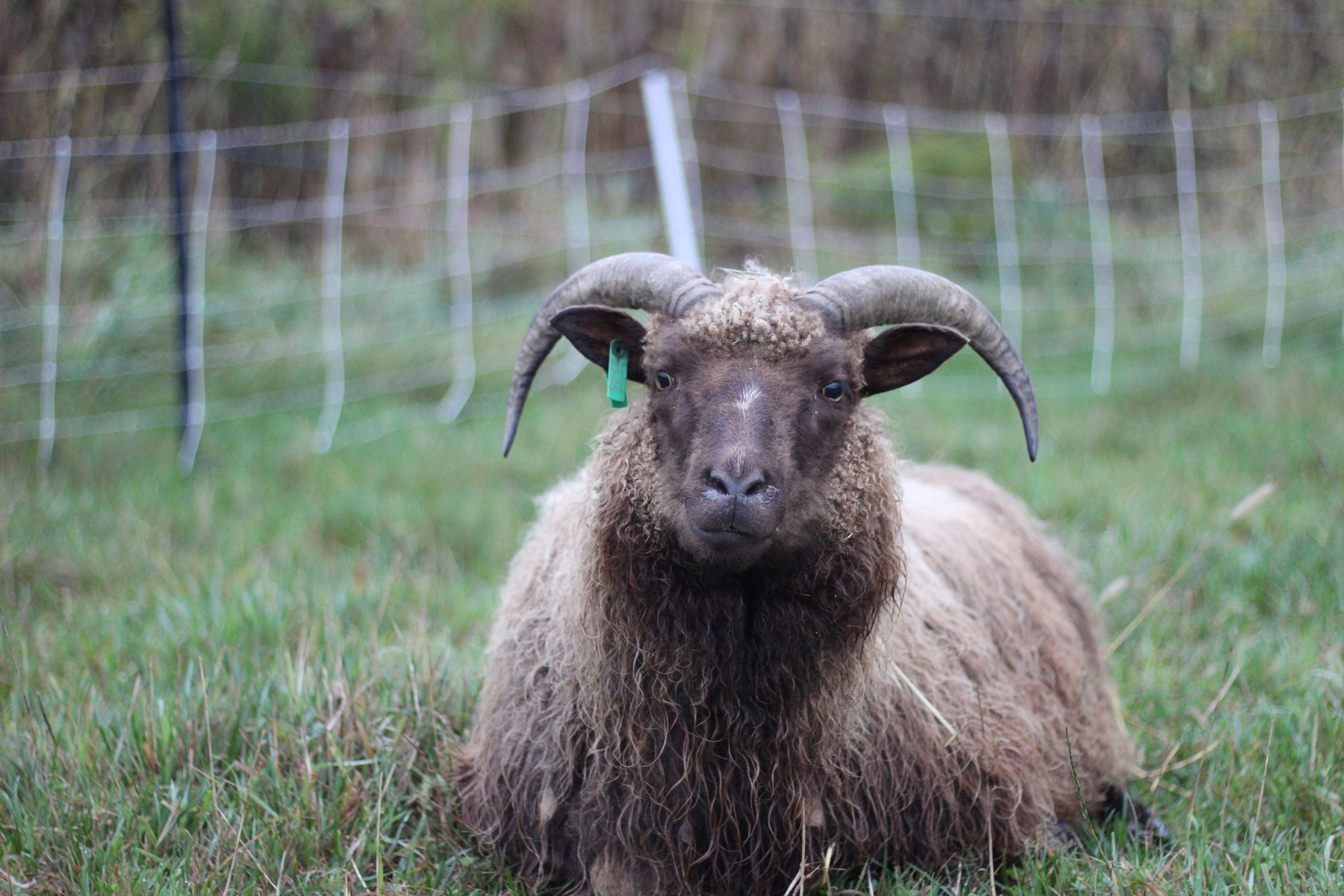
The highs and lows of 2024 Lambing Season
I would say this year has to go down as one of the most challenging, years in our farm’s history. All in all, the lambs born have been vigorous, beautiful in coloring, and are all thriving. For that, I am very proud and thankful.
This years lambing included 3 sets of triplets, (two lambs did die) a rejected lamb, death of one of our original jacob ewes, and a cesarean. Woof. What a year. We have gone years without ever having this much drama, and I guess fate finally caught up with me.
Triplets are not common on our farm. Last year we had one set of triplets. I believe the increase in fertility was a result of adding Redmonds Selenium 90 as a mineral supplement since our soil is deficient.
We lost our original Jacob ewe Stripes, to a difficult birth of a stillborn lamb which after speaking with the vet, we believe died in utero at least 12 hours before her water broke. It was a sad situation, and she gave us many beautiful lambs the last nine years.
Stripes before her passing
We have a bottle baby, that I lovingly named Louie. His mother has only ever had single lambs and after 2 days decided she could not count to two, and only wanted his brother. He gets to live with his brother, and mother but I give him bottles two times a day, along with one of the ewe lambs that was born a triplet. Her mother cannot give enough milk, so I am stepping in to fill the milk gap. Her name is Nesta. Louis has beautiful brown wool and will be a fiber pet here on the farm.
Last but not least, Peanut and her cesarean. This was probably one of the most anxiety inducing moments I have had the last 9 years of farming.
Peanut was the last of my adult ewes to lamb, and at first, nothing seemed to be amiss. She began to show signs of labor, and I patiently waited in the pen next to her. After a while, I began to realize that something was wrong. Peanut is my most gentle, sweet Vermont Icelandic ewe. I can pet her, and she is not afraid of me, and has a very calm demeanor. She was pacing a lot, and seemed frantic in a way that only me who knows her well, could tell was out of character for her, even if she was in labor.
I sleeved up to see if the lamb was positioned correctly, but I could not find the head. The lamb was coming out feet first, but the head was completely back and turned down towards the ground. Peanut is not a very girthy ewe. I knew this lamb was big for stature and there was no way I was going to be able to get it out without possibly injuring her. After a call to my vet, she told me to bring Peanut to the clinic she works at part time, and she would take a look. At this point the lambs front legs were sticking 6 inches out of her lady parts, and I was not at all confident this lamb was going to be alive once we got it out. It had been over an hour, and the lamb was not kicking or moving like they oftentimes do when you are trying to assist in the delivery. I loaded her in the trailer right as a nasty storm was blowing through that was bringing tornado watch type weather with it. The whole way to the vet’s, I kept thinking “ I just need to save her, but maybe he is alive. Maybe his cord is still attached” (once the umbilical cord is severed, this triggers the lamb to breathe. If they are not out of the amniotic sac or delivered, they will suffocate.)
When I pulled into the vet clinic, I was greeted by my Vet and several vet techs. Neither the vet tech or my Vet could re-position the lambs head, and it was decided that in order to save Peanut, we would need to do a cesarean.
This whole procedure was both fascinating and cringy to watch. Peanut stood the whole time, and did not make one bit of fuss. The Vet Tech shaved her rumen side area where the incisions would be, and the Vet administered several shots of lidocaine to numb the area. The incision was made and the ginormous, beautiful black and white lamb was removed from her body. The vet handed the lamb to the vet tech to dry him off and we heard a GASP from the lamb, he was ALIVE!! A few happy tears fell because I simply could not believe it! By this point it had been several hours and he was alive!
It quickly became obvious why Peanut had such trouble, and why we could not get his head turned. He had huge horn nubs, and weighed in at 9.96 lbs.
Peanut was stitched up and loaded up with antibiotics and I was sent home with pain meds to give her for a few days. The vet was able to look at her uterus and determine if there had been any injury that would indicate whether or not we should breed her again. Thankfully, everything looked great, he was just a big lamb, so we can breed her again.
I kept both of them in the trailer for several days after we got home to ensure Peanut was going to recover okay, and that her lamb was nursing well too. After all, he did have a difficult entry into this world.
The beautiful lamb we chose to name Cesar, in honor of the way he made it into the world. It took so many of use to get him out alive, that I am keeping him a fiber pet, and he will live out his days giving us wool, that I can spin into yarn.
Speaking of yarn: That is my focus on the farm for 2024. I picked up a spinning wheel from a local antique shop, and have been learning to spin so that once our fall shearing comes around (I am hiring professionals!) I will be able to offer raw wool for sale, and spend winter playing with wool, spinnng and Knitting in the coldest and darkest days of the year.
So what does all this mean for next year?
I am making some changes to the time of year our sheep lamb, and shrinking that window of lambing to make things a bit easier. We began lambing January 21st, and we even have a few more yearling ewes that might lamb in April or May. This is a LONG time for me to be in the vigilant mental state when on baby watch. This requires a longer time of feeding high quality hay to meet the nutritional needs. I tried time and time again, to have my rams separated (but still on the same farm) as my ewes, and every year I underestimate their unstoppable desire to breed ewes in heat. I have many broken gates to show for it.
I can say with absolutely relief, that this is NO MORE. A neighbor offered up his fenced in acreage and barn for our animals to graze, and my plan is to take our two pregnant cows ( I realized I haven’t done a blog post on them! I will do that next time!) to his house, along with the rams. For some reasons unbeknownst to me, the cows love our rams, and the feelings are mutual. This means that our sheep at home and at our other neighbors will be Ram-less, and there is no chance of unplanned breeding!
We will bring the rams to their respective breeding locations, beginning the 2nd week of October. This will mean I will have lambs later, but everyone will be bred at roughly the same time, and within a 30 day period, hopefully. This also means that the likelihood of overfeeding (which I think contributed to Peanut’s problems since she was moved into the maternity pen too soon) is drastically reduced.
I am always learning, adjusting and changing based on the events that I am faced with. This year has been no different,
-B
Sheepskin tanning workshops on the farm
Demonstrating scraping and softening the hide on day 2 of the class
I am having trouble knowing where to even begin this blog post, but I will just start with saying I am so happy and full of gratitude.
This year, we opened up our farm to people from all over the country, from all walks of life, from farmers to hobbyist, to people just genuinely interested in learning a new skill. It was a dream of mine, since we started raising sheep and tanning hides. I wanted to share with anyone and everyone, willing to learn. In 2022, we made that happen. It is really hard to describe how much joy it brings me to see everyone getting excited from each hide they chose, and transformed into a beautiful heirloom piece of art to keep in their home.
As we wrapped up our on farm classes for 2022, I decided to open up the registration for fall 2023, a bit earlier than I planned. This will allow people to get a seat and gift this workshop to a family member or friend as a holiday gift.
You can find the registration page linked below. For all upcoming classes, only deposits are required and the remainder will be due at a later date.
As always, thank you for following along and supporting small farmers and businesses!
Cheers,
Bethany
Preparing the Flock For Breeding Season
Now, you might be asking yourself, what exactly do you mean “prepare” for breeding season? Don’t you just put the boys with the girls and let them do their thing? Well, sort of! Every farmer is going to be different when it comes to the time of year they wish to breed their ewes. First, let’s talk about sheep pregnancy.
Heat Cycles and Pregnancy
Fun fact. Sheep aren’t like humans! (or pigs, or cows) and they can’t get pregnant every month. Now, I cannot speak for every sheep breed because there are a LOT of different sheep breeds. However, most sheep breeds begin to go into heat as the days get shorter. This shortage in daylight triggers their cycles. There are some breeds, like my icelandic’s, that will not begin to cycle until October. Our katahdin and jacob ewes cycle much earlier (say beginning of September) and we often have lambs in January and early February. Once a ewe begins her cycle, if not bred, she will cycle again in 17 days.
There ARE a few sheep breeds that actually can cycle throughout certain times of the year and give birth to lambs in Autumn. Dorsets, Finns and even Katahdins can do that! So, if you are interested in having lambs in the fall then maybe one of those breeds may be for you.
Sheep are pregnant for just shy of five months, around 147 days. Give or take. So, if you put the ewe in with the ram in mid September, you can expect lambs in February.
Getting the Ewes Ready For Conception aka Flushing
After ours ewes have nursed their lambs all spring and summer, they (depending on the pasture conditions) may need a little help getting their body ready for conception. This is also known as “flushing” the ewes. Flushing the ewes prior to breeding helps them put weight back on if they are a tad bit thinner than they should be. When they are in great physical health, and aren’t thin, this increases the ovulation which in turn increases your chances at getting twins.
If you see that your ewes are in a body condition score of 2 or less, than flushing them could help them gain weight and increase their conception rates. Ideally, we want our ewes to be at least a 3. “It should be noted that it takes three weeks on an increased level of nutrition to increase a BCS by one half-score.” https://www.canr.msu.edu/news/flushing-small-ruminants-for-a-higher-ovulation-rate
Flushing could mean feeding high quality hay, moving to a fresh new pasture, or feeding oats or corn or a premade sheep ration from your local feed store. For our flock of sheep, we feed corn, at 1/4-1/2 lb per head per day. When looking up feed rations, most are for sheep that are 150 lbs or more, only a few of our older ewes are at the 125 mark, with the rest being 100 lbs or less. Keep this in mind if you are trying to figure out how much to feed your ewes during flushing.
Why do we feed corn? It is readily available in our area, and high quality hay is not always on hand especially if we are below average rainfall, like we are now. Additionally, the kernel of the corn contains essential vitamins and minerals such as Vitamin E. Vitamin E is important for the growing lambs because if the ewes do not consumer adequate quantities of vitamin E and selenium during their pregnancy, then the lambs can get “white muscle disease”. (symptoms usually occur immediately after birth and they struggle to stand, and are often weak). Thus, corn has two purposes. Put weight on the ewes and as we continue to feed the ewes corn, their growing offspring will benefit from it.
We will start feeding a bit of corn to the ewes 3 weeks before I anticipate breeding season start. Which usually means by mid August, I am adding a bit of corn to their diet on the pasture. Sheep do not tolerate abrupt feed changes. It can upset their rumen digestive tract, so we start slowly with just a few handfuls a day and slowly increase to that 1/4 lbs of corn a day (and more if necessary).
What About the Rams and What is a Marking Harness?
Before breeding time, it is also important for me to check on the rams. I will check to make sure their hooves are in good shape and that there are not signs of illness or hoof problems. After they’ve passed their health check, it is time for their most worn accessory, the marking harness! Each ram gets their own color and wears this harness. The harness has a place holder for a wax crayon. When the ram mounts the ewe, it leaves a mark on her. I then count out 147 days and that is her anticipated due date. Now, what if she is marked but she didn’t actually conceive? Good question! Ideally, you should change out the marking harness crayons every 17 days and then you can see if the ewe came back into heat and adjust her due date.
Filbert (aka Fil, our Icelandic ram is wearing his harness and it has a yellow crayon. That face he is making is normal during breeding time and is called Flehmen behavior)
Peter, our other Icelandic ram is wearing his blue harness, and is also doing his Flehmen face.
Pollyanna has been marked! (September 2020)
What happens next?
During breeding season (September-December) the ewes and rams will breed and I will take notes and dream about baby lambs until then!
Polly was marked FIRST this year and her anticipated due date is January 25th. It is always exciting!
We have 28 adult ewes and we also have a group of ewe lambs that we will breed once we purchase another ram. Of the ewe lambs that we have, I plan to breed 12 of them. Those ewes will likely cycle later since they are 75% or 100% Icelandic genetics, and I will expect their lambs in April and maybe even May.
All in all, breeding season is a time to get excited about upcoming lambing season. Nothing brings me more joy than seeing big, healthy, pregnant mamas munching on hay during the winter when the snow falls. It is wonderful.
I hope you are all well and staying safe.
Talk to you soon!
Bethany
There's been an accident....
All I wanted to do was harvest pears.
Ever since we first saw our now farm that we OWN (long blog post coming up on that!) back in April, I was so excited to discover that we had pear trees! I patiently waited, and finally they were ready to be picked.
Long story short, the ladder I was on collapsed and I fell backwards from about 5 ft up and landed wrong on my knee. I fractured my tibia, and tore my ACL, LCL and Meniscus. (cue sad dramatic music here).
Falling off a ladder with such a traumatic injury, less than a week after you close on your dream farm was (and is) pretty devastating. I am scheduled to have surgery September 22nd and recover is going to be long, but I plan to try and make the best of that time by writing to you all here. Because of my long term recovery, we have launched a storefront with Aurora Blue Farm merchandise to help cover farm expenses during that 6-8 weeks where I will not be able to tan sheepskins as I normally would, nor keep every butcher date we planned, due to the logistics. (our truck is a stick shift, and I broke my clutch leg)., etc. We have hoodies, sweatshirts, T-shirts and even coffee tumblers with our updated logo! Thank you for all of your support during this time! The flock appreciates you!
I will keep you all posted on any new farm news and updates. Breeding season has started here on the farm and the next post will be ALL about what we do here on the farm to prepare for breeding and the pros/cons to lambing in spring or winter!
I hope you are all well!
Stay safe!
Bethany
Sheepskin Tanning at Slough Farm on Martha's Vineyard Island
A dream come true. Seeing and petting Scottish Highland Cows!
If you follow along on Instagram, then you already know that I spent the first week of February at Martha’s Vineyard Island teaching a weekend long sheepskin tanning class at Slough Farm. Here is a little recap of my amazing time there.
I spent several summers of my childhood (and as an adult) traveling to the east coast, specifically Massachusetts. We camped and stayed in Salem, saw Boston, and Plymouth. Because of my childhood memories, Massachusetts holds a special place in my heart. But, I had never been to Martha’s Vineyard. When Sophie from Slough Farm contacted me and asked if I would be willing to spend a week on their farm to teach a class, I HAD to say yes! After the initial shock (THEY ASKED ME!?!??) I was so EXCITED. Mind you, I was still very concerned about traveling out of state during a pandemic, but this was an opportunity to be surrounded by other farmers and I simply had go. I am so glad I did. This was a very memorable experience, and everyone at Slough Farm treated me like family and made me feel at home. I wish I could adequately convey how wonderful Julie and Sophie were to me (among everyone else I met there) and how much I LOVED spending my time with all the farmers in the class. Words just don’t seem to do it justice, though. It was rejuvenating. Like many others, I spent a lot of time in isolation in 2020. I felt detached from a “farming community” because I did not participate in the Oxford Farmer’s Market in 2020. Farming right now, and tanning hides is solitary work. I spend my days with very little interaction with humans. I see lots of sheep everyday, my pigs, and of course Magnus, but not humans! The only connections I have are through social media. I am not diminishing those connections whatsoever, because they are real friendships that I cherish deeply and those platforms are what brought me to Martha’s Vineyard! However, getting to laugh, teach and spend time with like-minding farmers, IN PERSON was balm to the soul. I am forever grateful for the opportunity, and I hope to come back to teach again!
I was able to drive around the Island, and of course I was the only person there. Which is totally fine with me. Obligatory selfie at Aquinnah Cliffs Overlook
The roads around the island are lined with rock walls. They were moved from the land and used as barriers or fencing to keep the sheep in. There are a LOT of sheep farmers on the island!
These walls date back to 1694. This was near the town of Chilmark.
My flight was delayed due to a snow storm, so I arrived a day later than planned. I flew to Charlotte, Boston and then took a tiny plane that people refer to as a “puddle jumper”. I am not going to even downplay it, I was a bit scared to get on the tiny plan. I was sitting right behind the pilot, and there were two other passengers. The pilot was wonderful and assured me it would be a quick and easy 45 minute flight, and he was right.
Blurry, but you get the idea. This was a tiny plane
SATURDAY
Saturday we fleshed the sheepskins, washed them and put them on frames to apply the brain solution.
Fleshing the hide to prepare the solution
I am using the fleshing blades Seth makes for this step.
Applying the solution
Emily and I working on her sheepskin
The brains have been applied to the sheepskins, and they are now on the frames. (normally, I like to fold the hides in half….skin to skin, to let the solution absorb. But, due to time constraints, this was our plan B. I have tanned this way before and it works just as well, so long as you apply a generous amount of solution. Photo Credit: Martha’s Vineyard Agricultural Society
SUNDAY
We were getting news alerts of a significant amount of snowfall heading our way for day two of the workshop, so we had to improvise! We did a zoom session for that Sunday and I answered any questions thatthey had. We also did a follow up zoom/facetime call the next weekend for those students to finish up their hides after I had returned home.
My first zoom class!
Photo credit: Julie, Slough Farm
THEN THE SNOW CAME…….
MY FIRST NEW ENGLAND SNOWSTORM
I am pretty excited about it too!
Beach Snowman
I never thought I would build a snowman on the beach, but I did!
Slough Farm raises Tunis Sheep. They are beautiful!
When on the island….
This was the BEST lobster bisque soup I have EVER had.
Lambing season 2021!
Right as I returned home from Martha’s Vineyard from teaching a weekend long sheepskin tanning class (a separate blog post coming on that!) we were hit with heavy snow storms, and ewes started lambing! It was an exciting time and we still have more ewes still to give birth!
Often I am asked why we have lambs born in the middle of winter and go through the spring, versus having all of them born in the spring. There are a few reasons why we lamb in winter. In the beginning, we had a much larger flock of ewes and raised lamb to sell at the farmer’s market so we needed to have them born as early as possible so we could provide a continual supply of lamb to our community. Lambs born in winter has it’s pros and cons. The obvious cons are the frigid cold temperatures that can occur in Ohio. But, as long as sheep have a place to get out of the elements, they lamb just fine. There are extra feed costs associated with winter lambing, because the ewes are not grazing on high quality spring pastures yet.
There are a few cons about spring lambing: Lambs born on pasture during warm temperatures are more susceptible to attacks from predators, and young lambs do not have the immunity to fight fight parasites that plague sheep, whereas older lambs say born in January or February have a head start on that. In the future, we are transitioning to lambing March-May.
Most sheep breeds will not be able to get pregnant any old time like pigs, cows, humans etc. They are what we call ‘seasonal breeders’. When the seasons begin to change towards the end of summer, the shorter daylight hours will trigger them to go into heat, which cycles every 17’sh days or so. Our rams were a marking harness that leaves a mark on the ewe to show that they have bred her. Using a marking harness is really important for my ewes that lamb during winter. I have a very good idea of when their due dates are and can keep them close to the barn when their due date approaches!
Polly and her ewe lamb, Penelope
Polly was “marked” marked by our icelandic ram Peter on 9-20-2021 and she gave birth to a big healthy girl on 2/15/2021
We have so many beautiful colored lambs this year! Our new ram Fil has proven himself and his offspring have lots of spotting!
Lucy gave birth to this beautiful girl! I named her Louisa.
I have felt so incredibly lucky this year, because all of the lambs are healthy and doing so well! We still have 7 ewes left to give birth. They are first time moms, so I will need to keep a close watch on them. They are due in April and May, so this is a very long lambing season, but I love it!
It is a very stressful time of the year on the farm, but also the most rewarding. Every year and season you are filled with hope and optimism and taking lessons you have learned the year prior and applying them to the season in front of you.
Thank you for being along for the journey!
Shepherdess,
Bethany
Preparing for Lambing!
““Many sheep but one Shepherd.”
― Lailah Gifty Akita”
My Dad always said that showing at the county fair in 4-H was like preparing months for one game. You get once chance to do it right, and that is it. That really stuck with me and I think it is just like lambing season. You get one shot and your entire year is based on those few months. Because of that, I make sure to give the pregnant ewes all the nutrition and vaccines that are necessary to give the best possible outcome. (more on vaccines later).
It is the most exciting and stressful time of the year for a shepherd. Loss rates for lambs are probably higher than one would think. Statistically, mortality rates in lambs range from 10%-20%. http://www.omafra.gov.on.ca/english/livestock/sheep/facts/12-031.htm) (Thus, if you have 20 lambs born then losing 2-4 lambs would not be unusual. Lambs are delicate creatures at times, and there is an old saying that “sheep are born looking for a way to die.” This is why keeping accurate records and making hard decisions about which ewes to keep and which ones need to go is important if you are not solely keeping them as pets.
Matilda with one of her ewe lambs in 2020
Lambing jugs. They are roughly 4x4 ft. Simple panels and pallets work fine
Preparation
There are a few things that I do, and have handy during gestation and lambing that make the lambing season go smoothly.
1) Barn cameras: We do not live on site at the farm, so having barn cameras to check on them during the day and night is a nice security blanket for me I rarely ever have to assist in a birth, but it is important to get the lamb in a pen (jug) with mom ASAP to make sure he/she is nursing, and to disinfect the umbilical cord. I like the cameras for this reason, so I know what I am getting into before I head to the farm. I use a Wyze camera and a wifi booster, both from amazon. But, you can also buy a wifi hotspot to use if you don’t have access to wifi. (Cricket has cheap plans for unlimited data)
2) During gestation: Nutrition is so important during the last 6 weeks of pregnancy, because that is when the majority of the development occurs. I feed our pregnant ewes .5lb of whole shelled corn, per head per day during mid gestation and continue until they lamb. Then, once lambs are born the ewes will increase their corn intake to 1lb per nursing lamb (So, for twins the ewe gets 2 lbs) and will have high quality hay and get molasses water for at least the first or day or so. This helps boost their energy and encourage water consumption. Ewes consume a LOT of water during lactation. It is important to make sure that they never run out, so having heated water buckets or frequent water checks is important to keep the milk supply going for those nursing babies.
3) Lambing jugs/pens: I make sure to have 3-4 lambing jugs set up weeks before lambs are due, because surprise births seem to still happen! These pens are nothing fancy and I use pallets and cattle panels to make them. They are roughly 4x5 and give plenty of room for the ewe and lamb. I usually keep one pen 5x5 or larger that I reserve for larger ewes with twins. After the lambs are born, they stay in those pens for a few days and up to a week. Then the moms and babies move to their communal area that I call the nursery. This area is not accessible to the rest of the flock. It is like a community for ewes and their lambs only.
SUPPLIES
Iodine- dipping the navel in Iodine keeps bacteria from causing infections such as naval ill.
Milk replacer- You can get this at TSC or any farm store.
Bottles nipples
High quality hay
Molasses- I have found warming up a bit of molasses to put in a ewe’s water really encourages them to drink and also gives them an energy boost after labor. I just started doing this two lambing seasons ago, and it isn’t absolutely necessary but they do seem to love that water after delivery.
Towels- I don’t like to dry lambs off with towels unless it is a seasoned trustworthy ewe, and it it is bitterly cold out. The risk you take with drying lambs off is that the scent may confuse the ewe. Let mom clean the lamb up and put under a heat lamp while she does it.
Heating pad- nice to have if you have a chilled lamb that isn’t necessarily hypothermic, but could use a bit of warming up.
Nutri-drench (this packs a punch to give chilled lambs energy) and a thermometer.
I also have a heat lamp handy, but I try not to use them due to fire risks, and most of the time the lambs do not need them. Only if they are small and bitterly cold in the teens, will I consider giving them a heat lamp. If a lamb is really cold, I will wrap the lamb up in a towel and heating blanket in the pen with the ewe until I can bring up the lamb’s temperature. A hypothermic lamb is one that has a temperature below 100 degrees. People often make the mistake thinking bringing a lamb into the house alone will raise the internal body temperature of a chilled or hypothermic lamb, but it won’t. You have to raise the core temperature slowly, by using temperatures over a 100 degrees. Some do this by placing the lamb in a bag and sitting them in a warm bath tub, or you can use blow dryers, heaters, or heating pads. Resist the urge to try feeding a cold lamb, because a cold lamb will not be able to digest the milk. Raise temperature first, then feed. That is why I use the nutri-drench because it helps “perk” them up while you are bringing their internal temperatures up.
Many people when they first start out raising sheep, want to have every item possible available to them. You really don’t have to! The items I listed are the essentials that I make sure to have because I almost inevitably need them every lambing season.
The barn is almost ready for 2021 lambing season, as I have a few tweaks to make before lambs start hitting the ground in February. But, every year I get so excited and this year is no different. I cannot WAIT!
Irisa drinking molasses water shortly after giving birth to twins.
Looking Forward
“The world is so empty if one thinks only of mountains, rivers & cities; but to know someone who thinks & feels with us, & who, though distant, is close to us in spirit, this makes the earth for us an inhabited garden.”
― Goethe
Well, I think we can all agree that we are ready to grab onto 2021 with the hope it might be a tad bit different. better. hopeful, however you want to approach it.
I hope that 2021 permits me to do some things I wanted to do more of last year: Sheepskin tanning workshops and demonstrations! In February, I head to Slough Farms in Martha’s Vineyard for a week to teach a brain tanning class! I am so honored and excited to be able to meet other people that are interested in this craft.
One thing I felt that was missing from 2020, was my sense of community (in-person), We did not attend the Farmer’s Market for the 2020 season, but customers, family and friends continued to show up for us. We sold out of lamb and even shipped lamb across the US! I am forever grateful for the support during such a tumultuous year for so many families. However, I missed SEEING everyone every Saturday. I missed my market vendor friends, and my customers. A LOT.
With the absence of personal interaction, I really made a point to connect with my instagram friends, and yes they are my friends! When physical interaction was limited, and nearly non-existent, having those farm conversations via message with my friends really helped me feel more connected to that sense of farming community, that I felt was missing with not participating in the farmer’s market. As farmers, we all were going through similar situations (like getting butcher dates!) and keeping up with the demand, when the grocery stores put limitations on the amount of meat one could purchase. (They did in Ohio at least, for quite some time). Those conversations with my insta friends really helped me along, and I am so glad for that online community!
On another note, I am excited that lambing season is going to kick off starting February 20th! (or thereabouts!) Our new Icelandic ram Fil, has proven to be such a great addition to our flock. He and Peter are getting along well! Fil is a moorit colored ram, and my flock goals are to add diversity or variety of coloring for different wool purposes. I want to spin the wool, (maybe a spinning wheel is in my future!), and have variety of sheepskins for the fall processing!
Filbert, aka Fil. Our newest Icelandic breeding ram.
I will do another update, but we also added another species to our farm….KUNEKUNE PIGS! Wendy and Mabel came from another local farm, Flourish and Roam located here in Ohio. Our plan for the future is to farrow pigs next year, and offer these perfect, manageable sized pigs for a small farm/homestead for others, and to feed families locally and across the US.
Mabel (left) and Wendy (right). Named after the characters on Gravity Falls, if you were curious.
I am going to remain hopeful and optimistic for this year, and I hope that everyone finds comfort, as I know that 2020 was not kind to many of us. I will share as much baby lamb and crazy pig antic content as I can, with the hopes it will lift some spirits in a teeny tiny fractional way.
(If you want to keep up with the farm, especially during the cute lambing season, you can sign up below)
October is my January
For most people, January is the beginning. A fresh start. In December, we set goals for ourselves and make promises we hope and intend to keep. We reflect back on the previous year and make changes to our lives for the year to come. But, for me that "new year" begins somewhere between October and December. Whenever the air chill forces me to bring out the wool sweaters from the basement and wash my quilted/insulated coveralls that I have had since I was 14 years old, and well worn Carhartt coat. Today, I began to feel that sense of the new beginning that is approaching. It will happen long before January 1st. Much sooner. It is about to be a new lambing season.
After leaving the house this afternoon, I grabbed my wool sweater, wool ear warmers, and gloves and headed to the farm to do my daily round of chores, pick up chicken feed, and harvest the remaining tomatoes that were "can worthy." Winter is coming. Temperatures are dipping below freezing tonight, and I had to bid farewell to the summer garden. It is bittersweet. We worked hard planting, weeding and harvesting from that 700 sq. ft. In return, it provided us with hundreds upon hundred pounds of food. It served us well. I walked through the garden, and it is quite a pitiful site. Weeds overgrown in places, bare spots in others. Tomato plants tilting and falling, some fruits eaten by birds and bugs. Pumpkins are still bright, but tardy to the harvest party. Soon I can pick the rest of the sweet baby pumpkins and transform them into chili, pies, breads and other festive foods. For now, they stay among the remnants of summer gone.
With summer gardens gone, comes lambing season. Or seasons? For us it seems to span several seasons. Mostly early December through April, but a few lambs will be born in summer. But, a new year awaits. I rode the 4-wheeler to the pasture where the sheep were grazing. I stopped and yelled for them, made a few loud thuds with a closed fist on my 4-wheeler to get their attention. Instantly, as if knowing exactly what I was saying, they look to me and come running. It is not my presence that triggers them to come, it is my voice. Harriet, one of my favorite and friendly ewes leads the way. She is visibly pregnant, but still runs with purpose, and makes it to the front of the line. The other half of the flock veered into the line formed by Harriet and towards me they ran. I opened the gate to the orchard grass pasture, that thanks to the recent and needed rainfall, grew several inches and is bright green. One by one, the flock descends upon the grass with enthusiasm, bordering on aggression, and chomps and eats as much grass as they can. Magnus brings up the middle of the flock and begins kicking and screaming in his typical Magnus way.
I sit on my 4-wheeler and watch. Observe. Counting each of them as they come through, if I can. So much of what I do everyday at the farm is simply watching. Listening. There is a lot of physical work that must be done. Lifting, carrying, pushing, hauling, moving. It is a daily occurrence at the farm. But, it is just as important to sit and watch. Sheep can be such stoic creatures. One minute they are fine and the next day you'll find them near death. It is a natural defense to predators and threats, or so I have read. If you are sick, you better fake it until you make it, or something is going to have you for dinner. So, as I watch and observe, I do my best to make notes in my phone of ear tags numbers and the health status of each ewe that stands out to me. Orange 24: "She looks healthy. Pregnant. Udder starting to bag up."
I can see there a several mamas besides Harriet that are starting to look profoundly pregnant, while others are just barely in the early stages of pregnancy. I have learned a lot over this last year, and rejoiced in great moments, and sat sobbing in they hay on other days. I am hopeful this year will bring new lessons, (hopefully much less painful) and hopefully, an infinite amount of joy. I miss the smell of baby lambs, and I desperately need to scoop them up in my arms and watch their tails wag as they nurse from their mamas. Oh my New Year, I cannot wait for you to get here.
Wedding, honeymoon and perspective
After a short engagement of less than 90 days, we married at the historic courthouse located in Hamilton. It was not a justice of the peace wedding, but since we met in law school, it seemed fitting to say our vows there. The reception was held at one of our favorite places, Hueston Woods Lodge. We spend a lot of time in those woods and at the beach, so it was our first choice to have our reception there. After the wedding, we traveled to San Francisco where we rented an RV and traveled along highway one on the coast. We had no itinerary, schedule or reservations. We simply boarded that plan with the intent of living in the moment and seeing where our days would take us. We met folks along the way who gave us suggestions on where to go, and they didn't disappoint.
California was beautiful. The landscape is ever changing from sand dunes to forests, to beaches and cliffs, to farming fields and small towns. The air smelled so incredibly sweet to us Ohioans, and the highways and roads were nearly litter free. The grass seemed so green it could be mistaken for astroturf. Wild and bright yellow flowers filled the fields and cattle grazed on the foggy hilltops that overlooked the Pacific. It was dreamy and breathtaking. Traveling with the intent to immerse yourself within the natural landscapes can put your life and your place in this universe into perspective. How small and insignificant I felt standing beneath redwood trees that had been rooted in the soil for thousands of years. This world is such a magnificent place and there is so much to see and experience. I am forever grateful that for the past year, my days are spent outdoors where I can see new life emerging, the cycle of life ending, and nature change within the seasons. There is a healthy rhythm that follows my days and it is one that works within mother nature. When you travel to beautiful places such as California, it is easy to find your home landscape "less than", unfulfilling or even depressing. But, I think about how those californians don't even know that their air is filled with the eucalyptus aroma because they smell it everyday, just as we may take for granted the beautiful falling snow and the crunching of vibrant leaves in the fall. To a Californian, those sights may be wondrous if they have never experienced them before. There is a lot of beauty in this world including where I live. California was dreamy and I want to explore more, but I will not take for granted the beauty that comes with living here. Everyplace is beautiful if you look close enough, and make an effort to not take for granted what you have surrounding you. Whether it be mountains, oceans, forests, grasslands, I will appreciate them all. Beginning our journey as husband and wife with an adventure of the unknown on our honeymoon was a beautiful way to start our lives together. No matter where life takes us, we have to stick together as husband and wife, best friends and partners. Adventure awaits! <3
““It had to do with how it felt to be in the wild. With what it was like to walk for miles with no reason other than to witness the accumulation of trees and meadows, mountains and deserts, streams and rocks, rivers and grasses, sunrises and sunsets. The experience was powerful and fundamental. It seemed to me that it had always felt like this to be a human in the wild, and as long as the wild existed it would always feel this way.”
― Cheryl Strayed, Wild: From Lost to Found on the Pacific Crest Trail”



